

TABLE OF CONTENTS


Sports & Culture
News Features Op-Ed
Sophomore POS pg. 2 Writing Center pg. 4 Cold or Covid pg. 6 Senior Parking Lot pg. 8
Dear Reader,
Stigma on College pg. 9 No Phone pg. 12 Sustainable Places pg. 15 Bad Parking pg. 18 LGBTQ+ pg. 20


Working Out pg. 22 Championships pg. 24 Satterfield pg. 26
Tipping pg. 28 That Girl pg. 30 American Studies pg. 32
We are thrilled to be launching our second print edition of Mouth of the River for the 2021-2022 school year! After publishing our first issue, the staff has learned the ropes and continues to meet challenges with persistence and optimism.
Flipping through this new issue, you will find a balance between current events in the high school such as the changes in the pro gram of studies and light-hearted stories like an article highlighting places to shop sustainably along the Seacoast. Our staff worked especially hard to ensure that there is a story for everyone in this issue. We all look forward to continuing to serve as the voice of the student body at Oyster River High School.
The cover story, “That Girl” written by Evy Ashburner, portrays the split-life of a teenager through social media and in daily life. The front cover is a collage of aesthetically pleasing images to represent a glorified life, while the back cover is a collection of photos that capture the reality of the life that most teenagers live. Many students and members of the community may be familiar with the inspiration of the cover and article: the people we see in social media that seem to live attractive lives.
With the help of the creative team’s inspiration, the cover photos were captured by Hannah Muessig. Be sure to also check out our online exclusive “Senior Advice” to hear familiar seniors reminisce on their high school years. Additionally, make sure to check us out on instagram and facebook at @mormagazine to stay in the loop, as we are constantly posting new content to our website. In the back of the magazine, MOR newly created QR codes to recent online articles so be sure to check that out!
As always, we are so grateful for our wonderful staff and Mr. Kelly for being so involved and excited about creating this second issue.
Lastly, a huge shoutout to this issue’s sponsors for being so generous to help fund our publication. You can check them out at the back of the magazine, as well as on our website! If you are interested in sponsoring Mouth of the River for the following issues or would like to subscribe to the magazine, contact us at mouthoftherivermagazine@gmail.com.
On behalf of the entire staff, thank you for picking up our magazine and supporting us. We hope you enjoy this issue of Mouth of the River!
Sincerely, Bhavana Muppala and Laura Slama, Co-Editors in Chief
The Faces of MOR

Mouth of the River Mission Statement
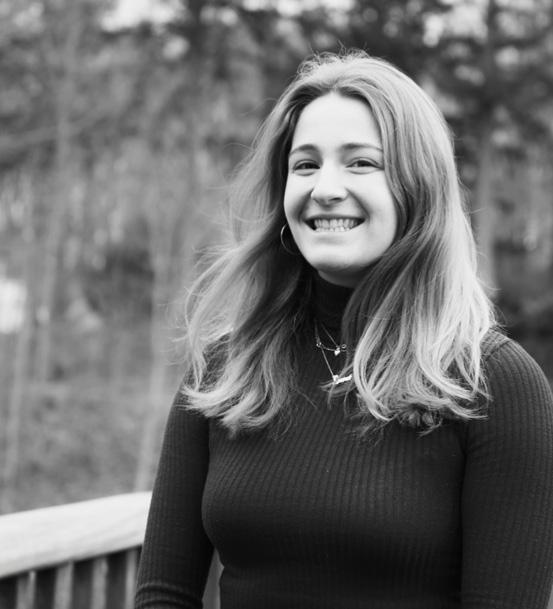
Mouth of the River seeks to reliably inform the student body, as well as the surrounding community, of interesting and newsworthy content in a modern, compelling format. Our goal as a staff is to give voice to the students of Oyster River, and have it heard by all our students. The opinions expressed in Mouth of the River represent those of the writers and staff.











A Look at the New Sophomore Program of Studies
Before the rise of the COVID-19 pandemic, students were offered a wide variety of courses in the Oyster River High School program of studies. This year, sophomores are more limited in their elective options than any other sophomore class.

Last winter, the Oyster River High School administration asked each academic department to brainstorm ways to shift their cur riculum to help rising sophomores fill in the gaps and “unfinished learning” resulting from remote learning. To cope with this unfinished learning, sophomores are experiencing a new program of studies specific to their class, which is in effect through the 2021-2022 and 2022-2023 school years. Designed to give students a foundation in core subjects, a shared common experience, and further preparation for the elective system, the new sophomore program of studies aims to help with the social and educational transition to high school. The addition of three required sophomore core classes were introduced to the program of studies and has been met with mixed feelings from students and teachers.
In past years, rising sophomores were al lowed the opportunity to choose their courses in the elective system after taking the required core classes of Essentials of English, World Cultures, and Biology 9 during their freshman year. However, this year, instead of signing up for specialized elective cours es such as Mythology or Environmental History for their core credits, sophomores were obligated to take the year-long classes of Sophomore English, United States History, and NextGen Science. Kimberley Sekera, an Oyster River High School school counselor, said that the goal of implementing these classes is “to have anoth er year, now that we’re all in, of shared academic experiences for
ment, and some were already planning changes, but they were all asked by the administration to shift their curriculum this year to account for the gaps in learning and relationship building for sophomores. In addition to making sure that students have a foundation in their core classes, the new courses aim to benefit students in other ways. “It’s really to give students another full year experience with a teacher because last year was so disjointed. [It’s so] students [can] have that continuity of the same teacher,” said Sekera.
Teachers benefit from this continuity as well. Matthew Pappas, head of the Oyster River High School social studies department, said that teachers “are able to keep the same students all year long. They get to know [the students] better and get to know their learning abilities better.”
Though intentions were positive for the new program of studies, there were concerns raised by students about the change. With the three new core classes, a year-long math credit, a year-long language credit, and graduation requirements, sophomores have a maximum of two elective credits of their choice. In com parison to past years, some students criticize this model as restrictive. Nic Brown (‘24) said that “we didn’t have a lot of options to choose our classes. [Administration] basically just picked all of them for us.”
This means that students have less time overall to take electives that they want to take. “I have to rethink how badly I actually want to take these classes and [if] there are other classes that I would rather take… Now the years to fit that in [have] gone down, so there is less time to accomplish what I’d like to do,” said Ella Higginson (‘24).
Grace Webb (‘23) said that she appreciated the opportunity to
students [so that they] can work on the academic skills for success across three core academic areas.”
Administrators concluded that one of the most important reasons to temporarily change the program of studies related to handling the COVID-19 pandemic. Two school counselors, Jason Baker and Sekera, stated that a major goal was to cohort lower classmen (grades 9 and 10) and upperclassmen (grades 11 and 12) in their classes to make it easier if circumstances demanded the change back to a half-in model. Cohorting upper and lower classmen would cause less overlap in classes and allow in-person learning time to be split between the two groups, if necessary.
The changes in the program of studies vary with each depart
choose the classes she had in her sophomore year because it al lowed her to discover and explore interests such as environmental issues. “I really liked Environmental History because I’m passion ate about sustainability. It was very interesting to me and I feel like I definitely enjoyed it more than I would if I just took a basic history class.” She continued saying, “you can choose classes you like which makes it more engaging and interesting so you want to do the work. It’s not just ‘ugh, I have to do this work for this class.’ It makes me more excited to go to school and be in those classes.”
Higginson agreed with Webb and said, “I kind of understand [the change], but at the same time I don’t like it because if you were picking classes that you enjoy I feel like kids would be more
“I have to rethink how badly I actually want to take these classes and [if] there are other classes that I would rather take… Now the years to fit that in [have] gone down, so there is less time to accomplish what I’d like to do.”
willing to apply themselves.”
Though there are some concerns around the sophomore pro gram of studies, students expressed some of the positive outcomes from the new courses. Webb expressed that she appreciates that the new program of studies includes analysis of literature. “It would have been nice to read some of the classics or good litera ture that I haven’t read in any of my classes,” she said.
Jennifer Weeks, co-head for the Oyster River High School En glish department, observed in her Sophomore English class that students are benefiting socially from a soph omore-only course. “I think it’s good for social reasons. They actually know what each other looks like and they’re building their friend groups. All that stuff that happens freshman year is happening for them this year. I don’t know if that would have happened without [a class like this],” she said.
However, Pappas proposed that sophomores could have also benefited from the diversity of grade levels that exists in other classes in the high school. “Having mixed grade levels in a class provides a unique dynamic. Older students tend to model better behavior that younger students will typically emulate… Older students tend to be more mature and stick to deadlines,” he said. For more information about student behavior this year, look into “Changes in Student Behavior at ORHS” by Lauren Hoppler.
Teachers have mixed feelings about the changes in the program of studies. A curriculum change for them means adapting to new schedules and creating new content for their class. On one hand, the English department faced the challenge of putting together a brand new curriculum for sophomores.
Weeks said that Sophomore English is “meant to be more of an extension of what kids [did in] Essentials of English… Our idea is that we would do more practice, focus more on themes, and more on different kinds of literature.” Sophomores have the choice of taking either Sophomore English with Expository Writing or Sophomore En glish with Journalism Writing. In both courses, the first semester concentrates on literary analysis and comparative literature, where the second either focuses on expository writing or journalism.
Though teachers in the English department found creating new content for the course to be challenging, Weeks felt optimistic about the change. “I was excited to be able to create something new, so I was okay with that,” she said.

Creating a new course was not something unheard of in the science department; they had already been discussing the pos sibility of making changes to their curriculum even before the COVID-19 pandemic. This year, NextGen Science replaced the Earth Science Systems course offered to sophomores in past years.
“The content is similar [and] it’s all based on the earth and earthbased systems. We’re all trying to also prioritize how fundamental chemistry and physics come into play within the context of earth,” said Jon Bromley, a NextGen science teacher. This is with the intent of preparing students for the physics and chemistry classes that they would take the following years.
In the past, rising sophomores were typically presented with the two options of taking Chemistry or Earth Science Systems for their science credit. As opposed to prior years, Bromley said, “we’re trying to encour age every student to take [NextGen]… If you don’t take NextGen, then you’re missing some core founda tional scientific thinking if you jump to Chemistry.”
Unlike the Earth Science Systems curriculum, Bromley said that “one of the differences is the way that, as teachers, we’re try ing to work together to be much more consistent in our approach. One of the goals for the high school, in our department, and in the district is to increase consistency between commonly taught courses. [This is] so that we’re giving an experience to kids that is meaningful and everyone is more connected.” Bromley expressed that appreciates this change and believes that it is a step forward in the science department.
The social studies department faced similar challenges in changing their curriculum as the other two departments, but they did not necessarily have to create content for the new course. Open to sophomores, the United States History course combines the content in the se mester-long classes of U.S. History I and U.S. History II into a yearlong experience. These two courses, along with American Studies, were removed from the program of studies.
Many students were upset that American Studies was no longer offered as an elective. Pappas said that the decision was made by administration and was due in part to the demand for faculty to teach the new United States History and Sophomore English courses introduced to the curriculum. “There’s certainly some scheduling challenges there because it involves two teach er’s schedules… Having two different teachers in the classroom teaching the material is of huge benefit and I hope that soon we will be able to offer it again,” said Pappas. For more information about the decision to remove American Studies from the curric ulum, check out Hannah Muessig’s article “Bring Back American Studies.”
Now that freshmen and sophomores will have had a full year of in-person learning and continuity, hopefully a sense of normalcy is returning to Oyster River High School. As of now, the current Program of Studies is expected to continue through the 20222023 school year.
 - Laura Slama
- Laura Slama
2021-2022 Program of Studies
Cover Design by Carter Santin“I think it’s good for social reasons. They actually know what each other looks like and they’re building their friend groups. All that stuff that happens freshman year is happen ing for them this year.”
The Right Place to Write

Have you heard of the new writing center at Oyster River High School? This year, ORHS is fortunate to have a full-time writing center.
Jacob Baver and Alexander Eustace, both alumni of ORHS, run the writing center and can help students with whatever writing help they need. From the seniors writing their college essays to the freshmen finally getting back into school and writing lab reports and papers again, to everything in between, the writing center is the perfect place to go for writing help.

The writing center holds so much opportunity for improve ment, as Camden Puiia (‘24) explains, “I come here during my study hall, so sometimes twice a week, maybe three times a week. I’ve benefited from it not just on my assignments, but in my per sonal writing as well. I see myself using the skills that Mr. Baver and Mr. Eustace have worked on with me and producing better work overall.”
Puiia explains that, “one, [the writing center] benefits your grades and two, it makes your writing skills better and will help you in school and [prepare you for] college.” Many other students like Puiia have used the writing center for their assignments, but also found it to be a good place to get work done without any pressure. Baver elaborates on this, explaining, “students come in more than once. I’ve heard from these students that their grades are improving, and having seen and interacted with them, they feel more confident as writers.” The writing center is simply the
perfect place to go for a stress free environment where you can learn new skills and not just improve the writing you’re working on, but your overall writing skills too.
ORHS teach ers believe the writing center will improve the students’ writing and in the end make them feel more confident in their writing and projects. Kara Sullivan, an English teacher at ORHS, explains that “students will benefit from the writing center and improve their writing skills all together, not just one particular piece of writ ing.” Sullivan, along with other
teachers at ORHS, are so excited to have the writing center and hope that their students will take initiative and use the resources available to them.
Hannah Hatfield (‘22) says that her time in the writing cen ter “was a really good experience. I went in looking for help with my college essay. I had it roughly started, but I wanted to expand how it was written and make sure everything worked well in it.” Hatfield was able to benefit from the writing center, along with many other seniors and juniors, to make her college essay better. Baver also explains, “[college essays] have been a lot of fun, especially at the start of the year, where you don’t see as many writing deadlines. We are able to help balance the academic strengths with GPAs and also work to make the essays flow.”
With all the college essays have come the acceptances. Baver says that, “so far, I know of two students that have been accepted and we are hanging their acceptance banner on the wall to celebrate for them. I hope soon we can fill it with more students getting accepted.” This is a great way for students to feel content with their work, but also let other students see how beneficial the writing center is and what can come out of it.
Countless times, students mention the vibes and comfort ing space the writing center has to offer. Baver says, “there are perks to being in a small space. It’s easier to be alone with your thoughts at times, which can be very valuable when you are writing.” Hatfield continues to explain how she particular ly enjoys the writing center’s atmosphere. “It’s always calm and there’s music playing, it’s a very inviting and welcoming space that really made me much more comfortable asking for help on such an important essay,” she says.

Baver and Eustace have worked together to make the writing center a calm and chill environment where students can work and improve their writing skills. Baver says, “it’s an atmo sphere where you’re going to get some work done, but we are also going to have some casual conversations that might stray away sometimes. When you leave, you feel more confident about it and comfortable coming back in because you know what to expect.” Focus ing on forming connections is a large part of the center’s philosophy.
Baver ex plains, “Eustace

and I believe the assignment is one thing, but we care more about the students than we care about the assignment. And with that, we’re hoping that more people can come in here and be produc tive in an environment where they feel comfortable.”
Eustace explains his goals for the writing center and overall what he hopes it brings to ORHS. “If we continue to help indi viduals with not just their assignment, but their writing habits overall, it will lead to them becoming stronger writers and not needing us anymore.” Eustace also relates to a greater prospect of not just strengthening individuals’ writing skills, but the school’s as a whole. “It is a resource that an academic community can use to improve the overall writing and writing habits of a larger group,” he says.
The writing center is a valuable resource ORHS has to offer. Hatfield explains, “I get that it can be kind of intimidating to ask for help or use a resource, but the school offers it and I was able to benefit from it, so I would definitely say take advantage of it.”
The writing center is on the second floor in room C217. Feel free to drop by any period and work with either Mr. Baver or Mr. Eustace on your writing. They have created a helpful environment that welcomes everyone and makes the writing center the perfect place to sit down and get the “write” stuff done.
 - Jen Newick
- Jen Newick
Cold or Covid?
With all the normalcy being back in person at Oyster River High School has brought, the normalcy of cold and flu season has also returned. Less normal, however, is the added stress of questioning whether you have just a common cold or the much more dangerous COVID-19.
During the 2020-21 school year, students were remote until early April, meaning the typical cold and flu season was skipped over. Recently, colds have been spreading around at ORHS for the first time in over a year. Meanwhile, COVID-19 case counts are on the rise in the Seacoast NH community. Since symptoms of colds and COVID-19 are very similar, many feel stressed about whether they just have a cold or if they have COVID-19, and feel self-conscious about going to school even after following ORCSD safety protocols.
As of mid-December, COVID-19 cases have been high. According to the NY Times the Strafford County, NH positiv ity rate was 13%. The site said, “cases have increased recently and are extremely high… The test positivity rate in Strafford County is very high, suggesting that cases are being significant ly undercounted.” To find more recent facts scan the QR code. Many people at ORHS have been getting sick and each has handled it a bit differently. Shauna Horsley, an English teacher at ORHS, was sick with a stomach bug during quarter one. This brought symptoms similar to COVID-19, such as a fever, nausea, and vomiting. She is a part of the SASS (Safer at School COVID-19 Screening) Program, so she receives a COVID-19 test weekly. When she developed symptoms, she said, “I had a fever of 102. I was definitely concerned [it was COVID-19. How ever,] that day when I came down with the sickness, I had my Covid test at school and it was negative, so that was reassuring.”
Eleanor Raspa (‘23) had a cold during quarter one before case counts started rising so dramatically. At this time, she was not as worried about her symp toms being COVID-19 as she had just been around people with colds. She said, “maybe I should have been [worried it was COVID-19], but I also know it’s cold season and people still get colds.”
Tate Sullivan (‘22) had a slightly differ ent perspective when he had a cold around the same time as Raspa. His brother had been sick with a cold and tested negative for COVID-19 so he said, “I wasn’t too worried. I layed low for a little bit, but as the days went on, the
gears started turning about ‘is this Covid?’ And if it is, I should get a test so I can tell people and get that information out as soon as possible.”






Although Horsley, Raspa and Sullivan were able to deter mine that they did not have COVID-19, their worries appear to be valid. Zoe Boyd (‘22) had COVID-19 towards the beginning of quarter two and spoke about her experience. “I wasn’t feeling super sick. I had kind of a headache and was like ‘I can’t go to school today,’ but I didn’t really think that I had Covid.”
Although Boyd was the only of these people to test positive for COVID-19, each of them went to get a COVID-19 test. This is because of the district policy about coming back to school after being sick. Kim Wolph, the nurse at ORHS explained this policy, saying, “along with a negative COVID-19 test, they need to be fever free and no vomiting for 24 hours without the use of Ibuprofen or Tylenol to come back to school.” She continued, “all students and faculty need to be able to pass the pre-entry questionnaire, located on our district website. If they cannot pass the screener, they are to make contact with the building nurse and the nurse will triage and determine next steps.”
Even after receiving their negative COVID-19 tests, Hors ley, Raspa, and Sullivan chose to stay home. Raspa was out of school for 4 days. She explained why she made this decision and said, “I might have gone in on a normal year to ‘tough it out.’ I don’t normally stay out that long, but it was just a really bad cold.”
Horsley said, “the policy has always been that if you have a fever, you’re not supposed to return to work for [24] hours after the fever breaks. I think that it’s so hard to be out whether you’re a teacher or a student, that sometimes we look at that rule and we’re like ‘well…’ and Covid has forced us to really think about spreading any sort of virus.”
Reducing the spread of viruses is especially important for people like Sofia Self (‘23). They have Type 1 Diabetes, an autoimmune disease. Self said, “I’m otherwise a pretty healthy person. Everything with my body is pretty much fine, except my immune system. With Covid, if I were to get it, it’s kind of a 50-50 chance whether it would be super detrimental [to me] or kind of fine like everybody else.”
Self had a cold and experienced a bit of worry about it. “There is a big added layer of stress for people with autoim mune diseases because you don’t really know if it’s going to affect the rest of your life and how your body works forever,” they said.
Another reason students and staff may stay home for longer is because of their symptoms. Sullivan said, “[when you are] coughing or sniffling, you’re like, ‘I swear I don’t have covid!’ kind of as a joke but also it’s a serious concern that some people can have.”
Raspa also shared this perspective and said,
“I [feel self-conscious] because whenever I cough, I get a weird look, like ‘oh my god does she have it?’”
Horsley took multiple COVID-19 tests before coming back to school but said, “I was very vocal about [testing negative] even though I knew I didn’t have to say anything. I just felt like I had to say, ‘I’ve been out sick with a stomach bug and I know I don’t have
Boyd also had the self-conscious feelings felt by those who just had colds or bugs when she had COVID-19. She said, “I definitely felt self-conscious about people knowing I had Covid because I knew I had been following protocols but I felt like other people would see it as me being irresponsible.”
to make contact with their teachers to check in regarding schoolwork. Nobody has to share their own personal health status, but checking in with teachers and staying on top of work through Schoology is beneficial when able to do so,” said Wolph.

Boyd was devastated about being out of school for so long but said, “all of my teachers have been really helpful and really concerned about me getting better. It makes me feel a lot more comfortable knowing that they all want to help me get back into the routine of things.”
From a teacher’s perspective, Horsley said, “another real concern is not wanting to bur den your coworkers with taking responsi bility for your classes. That’s another layer to it that I was definitely thinking about and appreciating how people stepped up.”

With right now being the height of cold and flu season, many might be getting sick even if they follow the rules. “If somebody tests positive for COVID-19 they are out for 10 full days from ei ther symptom onset, or test date if symptom onset is questionable. We encourage all who test positive (or guardians if appropriate)




Even though it’s hard to miss school and rely on others, it is also important to try and keep everyone as healthy as possible. Right now is the height of flu and cold season and COVID-19 is still a problem. Most times the sniffles will just be the sniffles and a cough will just be a cough, but it can be stressful and responding correctly by following the safety protocols can help keep yourself and others safe. Raspa said, “it’s just unfortunate that we got stuck with a virus that is so similar to a common cold. A lot of people get colds and that’s still a normal part of our lives.”

Stigma Against Senior Lot
So many students, so little parking, a situation facing Oyster River High School as students, and the mixing of traditional parking has upset many students.
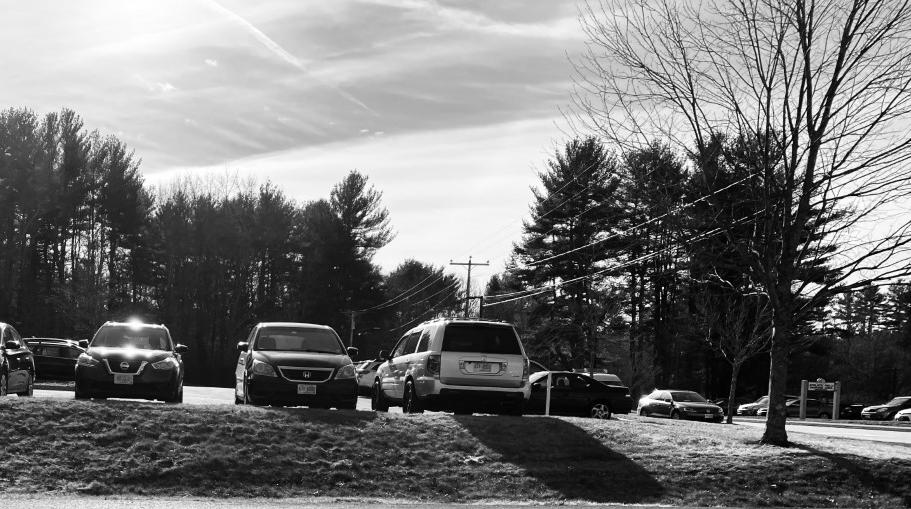
This year, all students are back in school and taking on new challenges. One of these challenges is the lack of parking spots. Oyster River High School has four parking lots where students typically park unoffically named; Upper Senior lot, Lower Senior lot (also known as the Athletic Parking lot), Tennis Courts, and the Junior Parking lot. While this may seem like a large number of lots, many are smaller and some are used for Oyster River Middle School staff due to construction. Because of this, juniors have started park ing up in the senior lot, which is upsetting many seniors.
While the seniors have deemed their lots and claimed where they choose to park, this is actually not enforced by the school, only the students. Mark Milliken, Oyster River High School’s Vice Principal, has heard about what each lot is called, but says, “I’ve heard people call it [the senior lot], but we’ve never desig nated lots for certain classes... it’s been called the senior lot, but since I’ve been here, it’s never been designated a senior lot.”

Milliken also goes on to discuss that because of the lack of parking, having lots for different classes would actually be impossible to enforce. “We have so limited space and so many people want to park [in the school lots], that it’s too difficult to create a lot for seniors only.”
Even though they’re unofficial lots, some seniors are still
the lot, but does not want the spot she parks in every day to be taken. “The biggest thing that gets me upset is when peo ple don’t park in the same spot. I feel like everyone has their designated spots, but [it’s frustrating] when juniors are taking people’s designated spots.”
With all the frustration around the parking lot, the juniors who have parked in the Upper Senior lot have really not heard anything about parking up there and how it is wrong. Reed Lar son-Dennen (‘23) has been driving to school since sophomore year because he had returned to in person learning last year. When Larson-Dennen started driving to school, he noticed “that most of the sophomores would park in the Tennis Courts.”
Now as a junior, Larson-Dennen has started parking in Up per Senior. Despite the apparent anger from seniors however, Larson-Dennen has not heard anything from the seniors when parking in the lot, saying, “personally, I’ve had no one come up to me ever and say anything. I know that some seniors are mad at other seniors for taking their spots.”
What about the reverse situation of seniors parking in what is normally considered the junior lot? Audrey Sigmon (‘23), has just started driving to school this year and always parks in the junior lot. She has recognized the aggravation that seniors feel when not having their lot respected. However, Sigmon does not feel annoyed when seniors park in the junior lot. She says, “I
upset with juniors parking there. Avel Durant (‘22) has seen the number of juniors parked in the Upper Senior lot and has become very upset by this. “It’s called ‘senior lot’ for a reason. If you’re a junior, you should not be parking up there.” But is this what seniors are upset with, or are there other factors as well?
With no designated lots comes no designated spots as well, all students are free to park in any spot and are not conformed to one spot, which has been done in the past. However, as students have gotten later into the year, both juniors and seniors have come to have typical spots they park in everyday. Carmela Williams (‘22), does not get upset when juniors are parking in
don’t feel upset because it’s their choice and they should be able to park anywhere.” What Sigmon believes is that the seniors should have dominion over the parking situation, a certain seniority.
So who is really upset by this issue and how can it be tackled? As the school year progresses, the conversation about the lots has become less and less. Is this because more people are under standing the unwritten rules are becoming more understood, or people are recognizing that the lots will never be fully sanc tioned to just one grade? In the future, perhaps more diverse parking lots will be seen.
- Tess Brown“It’s called ‘senior lot’ for a reason.”
The Next Step After High School
College. It’s hung on the school walls, it floods our inboxes, and the question “where are you applying?” pops up constantly from both teenagers and adult figures. For many students, a 4-year college plan is an expectation and their interactions with other options are limited.

As students become upperclassmen, they need to start think ing about what they want to do after high school. 70-75% of Oyster River students continue to a four-year university leaving only 10-15% to community college, and even fewer students continue onto something else. In the 70-75% of students who go on to college, there are both students who wish for an academic career and those who don’t know what they want to do and just assume college is their best option. In 2020, Isabella Crocco (‘21) published MOR’s, “Why are you Going to College?” She talked about the stigma of those who go to a community college and the pressure to go to a four-year university. These stigmas are still present and that is likely due to missing information about other opinions after high school. Here are the benefits students can gain from going to trade school and community college, and how they can get involved.
While students choose where they go next, there can be a lot of pressure from community members. ORHS school counselor Jason Baker thinks that it’s because that is what everyone around us is doing. He said, “I think at Oyster River, especially since it’s in a college town and there are a lot of university personnel who live in Lee, Durham, and Madbury, we have a high value on education. Community members went through a lot of educa tion themselves…You have a lot of student desire to do the same thing.”
Dillion Labonte (‘22) who is considering trade school and college, has received community pressure to go to college and also to get into a top school. “I feel that most of our students go onto college. We have a lot of people who are going to big colleges or impressive colleges like the Ivy League and whatnot so there definitely is that pressure.”
Jaden Smith (‘21) who chose the community college New Hampshire Technical Institute for nursing, also received pres sure and some judgment for not choosing to go on to a wellknown academically successful university/college. He explained, “My piano teacher, when I told her [I was going to community
college], said ‘aww Jaden, you could have done better.’” I was a little offended because NHTI is a really smart decision for me.”

When it comes down to it, going to an expensive and competitive college is not for everyone. Other paths can lead to successful and happy careers. There are many options for stu dents after high school, including community college and trade school. Community college is usually a two-year program where students can get a work training certificate, an associate, or cred its transferable to a 4-year university. Trade school is a two-year program where students are taught the skills to get a specific job, usually a job that takes more hands-on skills.
Baker explained that there are different factors in a student’s decision on where to go after high school such as different inter ests, financial needs, goals, and comfort zones. He explained, “I think there are benefits in every way. There’s definitely benefits
going to a four-year school, and getting out of New Hamp shire… [but] there’s value in everything our kids do. You have to find out what you need.”

Trade School:
Ron Senet, a currently licensed electrician in multiple states who works primarily in NH, explains why some students may not choose college and instead pick the trades or something else. “For a lot of people in high school, that structure is not how they learn best and it doesn’t interest them. Some people just don’t perform well or do well under this type of structure that schools are set up as. Not only that they are not necessarily engaged or interested in doing academic things like that. For a lot of those people, they like working with their hands.”
For Labonte and Sabrina Gullo (‘22), some of the elements of what Senet said is true to them. Gullo thought she was going to college for a while but wasn’t excited about it. “I mean up until freshman year I was like yeah I’m gonna go to college for something, I don’t know. I have to go to college right? At least throughout middle school and freshman year, I heard college, college, college. Then when I heard about the trades, I was like ooh here’s another option I could totally go into... something I actually love.”
Senet didn’t want to go to college and the trades ended up working very well for him. He explained, “I like my job a lot. It definitely takes the right kinda person to want to do it. It’s
very hard work. It’s pretty dirty work but it’s pretty rewarding I feel. I’m not the type of person who can be happy sitting around in an office and working at a desk. There’s always something new and you’re always seeing something else.”
Students who like some of the elements in Senet’s job may want to check out the trades and take some classes. Oyster River provides trades classes taught by Michael Troy. Troy teaches woodworking, advanced building construction, mechanical engineering, and electrical work. In these classes, students can gain trades skills and work on cool projects like launching rockets, doing basic wiring, and building things out of wood like chairs. These opportunities are great ways for students to learn if they enjoy working with their hands.
Another way students look into the trades is through classes at Dover. At Dover High School, there is a much big ger shop, with more tools and teachers. Labonte and Golding both love their Dover trade classes. They said there are some amazing guest speakers and building opportunities. Gold ing explained, “We are starting to build a shed for someone. That’s cutting and assembling and we are assembling it with a company, so that’s pretty cool. We get to hear what they are into, what they are doing, their profession, and how they got into it; I think it is awesome to learn from people. Later we are going to be building an actual tiny house which is really cool.”
Labonte loves working with his hands and having these experiences, but is still considering college because he’d like to run competitively on a university team. Labonte explains that choosing between the two is a big financial decision. He said, “At Manchester’s community college if I did the [electrical] line program it would only be six grand total before financial aid or scholarships. College is going to be a lot more than that per year. I’ve been looking at [Southern New Hampshire Universi ty] and talked to their coach because he reached out to me. It’s $18,000 a year before room and board; that’s $72,000 for four years.”
Choosing college is a risk financially that doesn’t make sense to some students. According to Midwest Technical Insti tute’s article “Trade School vs College: A Guide to Weighing Cost, Timelines and More,” trade schools usually cost $5000-$15,000 total in contrast to a four-year school that costs on average $32,500 per year according to the College Board. Spending $32,500 per year with debt on top of that can be hard for a student to pay off. Choosing not to go to a four-year college also doesn’t mean that students don’t make good money after school. Trades jobs on average make $81,414 per year depend ing on experience level and type of trade, according to The Value of Trade Schools in Today’s Economy, by Best Colleges.
Community College: Trade school is not the only way for students to get less expensive education. For those who want to continue aca demics, community college can be a great option. Community college costs on average $3,440 a year and can get you good jobs. Smith’s two-year nursing program will still give him a certificate for the job he wants, nursing, and the same money as any other nurse (the average American nurse makes $75,510 per year). Many students also transfer to a four-year school after 2 years to continue their education. In New Hampshire, there is a credit transfer system that ensures students can transfer community college credits to the schools: Granite State College, Keene State College, Plymouth State College, and the University of New Hampshire. Some universities after community college require more planning, to make sure the credits being taken are transferable. Other universities and colleges require more planning in that students need to check with councilors to see if credits will transfer.
Although Smith can work with his two-year certificate he plans on continuing and at least completing his bachelor’s. “I think after my two years I’m definitely going to get my bache
lor’s and luckily there is a credit transfer system.”

Some elements of community college wouldn’t be fitting for some students. A lot of community colleges don’t provide dorms, the campus can be small and spread out, commuting may be required, and some opportunities like clubs and sports may be more limited. These elements vary in importance for different students. Smith explained, “There’s the college experi ence side of things. If someone is going to UNH they are going there to get the experience of being a college kid. At NHTI you’re not getting that. It’s a smaller campus.”
For some students, the money isn’t worth the college ex perience. For Smith, missing out on some parties and sports wasn’t a deal-breaker for him. He’s made friends and loves his class. Academically, he doesn’t feel he’s missing out on a lot either. He explained, “Actually in the two-year program that the community provides, I’m getting right out in the clinical setting right in the hospital within my first few weeks. Where as if I went to a four-year college the first two years I’d just be doing lectures and not even be able to go to the hospital.”
While students think about where and what they want to do after high school, it’s important to evaluate all options and truly regard which option makes the most sense. All experiences can lead to future career success. None of them measure one’s intelligence or potential. If an option after high school sounds like just a chore for a reputation or money, then perhaps the program isn’t for you, at least during the present moment. Other options for students after highschool include internships, travel abroad education/work, starting a business, or completing a short licensing program like to be a nurses assistant.
Senet explained that success doesn’t come from what or where you pursue something. “You can be a successful elec trician like you can be a bad electrician, just like you can be a successful lawyer or a bad lawyer. It comes down to you and how much you want to put into it, study, learn, and how much drive you have.”
Students’ passions, goals, and life positions change over time. Four-year colleges, community colleges, and trade schools are not the only options. Students may choose to later change their education path and pick up more school later in their life. Pick the plan that sets you up for a life you love, a stable future position, and something exciting to you and change it if you change. Your future is about your happiness, and transformation, not anyone else’s.
Art“For a lot of people in high school, that structure is not how they learn best and it doesn’t interest them.”
- Ron Senet
- Hannah Muessig
by Ria Varki
I Went Without My Phone for A Week
This is What I Learned
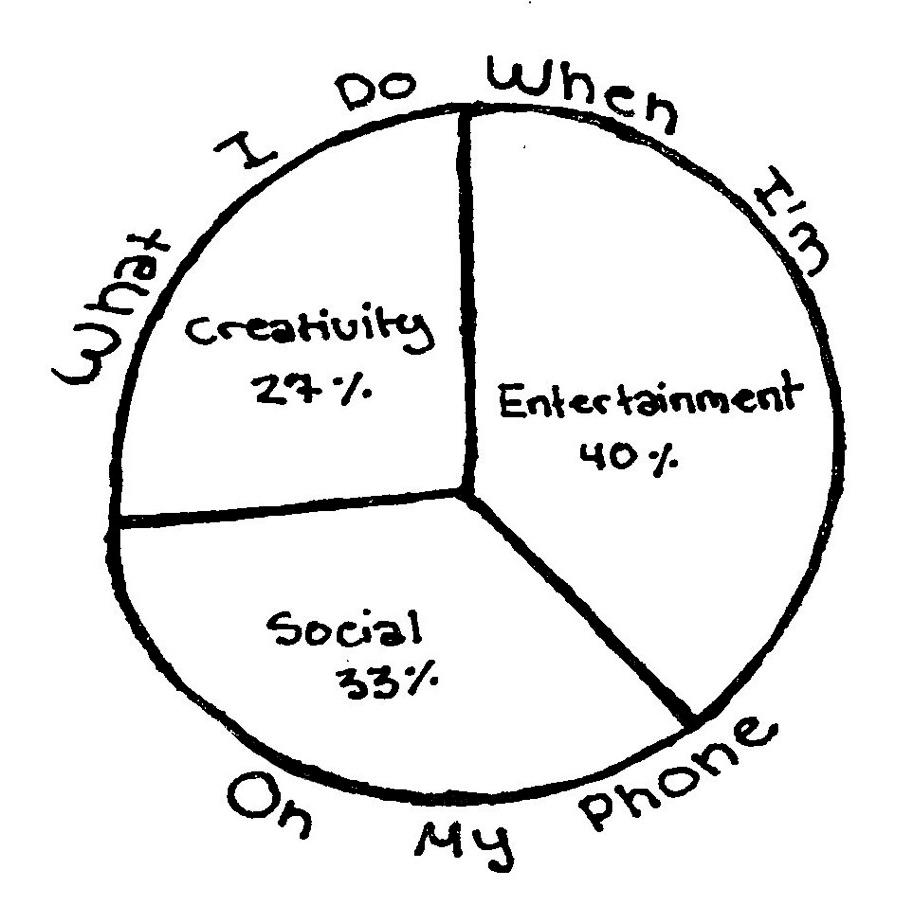
Have you ever had one of those moments where a quick and casual look through Instagram or TikTok somehow turned into hours of scrolling? I know I have, and every time it happens, I end up feeling like I’ve completely wasted all my time and energy.
There has been heaps of research that shows the addictive nature of phones and how it can negatively impact our well-being, whether it be through lack of sleep or constant anxiety and stress. For teens specifically, a 2019 Pew Research Center Sur vey found that, “54% worry they spend too much time on their phone, and of those who say they spend too much time on the phone, roughly half (53%) say they have ever cut back on the time they spend on their cell phone.”
I definitely think I’m too dependent on my phone. My screen time fluctuates week to week, but in the most recent analysis (which is conveniently curated by my phone itself), I was on it for an average of 6 hours and 34 minutes per day. I am below the national average of 7 hours and 22 minutes per day, according to a 2019 survey titled “Media Use by Teens and Tweens” from Common Sense Media, but it’s not much to brag about. That’s still 45 hours and 55 minutes per week. Not to mention, I’m spending 40% of my time on entertainment (Netflix, Youtube, etc.) and 33% of my time on social platforms (Instagram, Snapchat, etc.). Essentially, my time is spent rewatching episodes of The Great British Baking Show and The Office, or mindlessly scrolling through meaning less content that I barely remember.
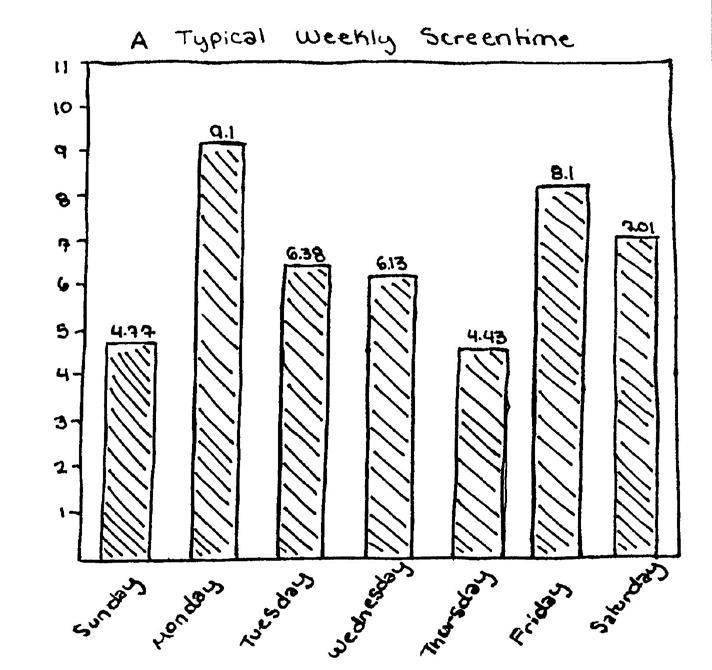
Other than screen usage, it’s also important to note that I have my phone with me everywhere I go, and I pick up my phone up 128 times a day on average to check for random notifications. If my phone is missing, I often get worried and frantically search for it.
I’ve even taken a few “Are You Addicted To Your Phone?”online quizzes, and my final results always said that my phone usage was a little concerning. I understand that I have some addictive tendencies, and I know I could be spending my time being pro ductive or doing things that actually make me happy, but either by lack of willpower or sheer reluctance, I’ve never bothered doing anything about it.
I finally decided to make a change to my behavior. No more sitting around, wishing I was doing something better with my time. So, I told myself that I would try and go an entire week without using my phone and see if it made me feel any better. The design of the experiment was simple: No phone, from 12:30 pm on Sunday until 12:30 pm on the following Sunday. It would be completely shut off, and placed in a random drawer that I wouldn’t find myself feeling the urge to open. I allowed myself to use my computer to communicate with people, but I tried to limit the use of iMes sage. If people wanted to talk to me, Outlook was now my prime mode of communi cation. Here’s how it went.
NOVEMBER 28TH - DAY 1
12:30 pm - Going into the experiment, I was excited, but I also felt a vague sense of dread of giving up my routine and trying some thing new. My original plan was to do the experiment early in the school year in September, but I didn’t think I’d be able to conduct it effectively during volleyball season. Granted, I did need to communicate with my coach and teammates, but I couldn’t help but notice how easy it was to make excuses and put it off. However, I finally mustered up the courage and locked it into the drawer on November 28th. So long phone. See you in a week.
2:00 pm - I experienced my first real challenge of life without a phone. When I got into my car, my immediate instinct was to plug my phone into my aux so I could play the recently released album, Red (Taylor’s Version), but of course, my phone was locked away in a drawer. As a die-hard Swiftie, I was disappointed that I would have to succumb to listening to the radio, but I did my best to tolerate it.
8:00 pm - I realized that I needed to set an alarm since I wouldn’t be able to use my phone. My step-mom lent me her analog alarm clock, which was harder to use than I thought. She laughed when I asked her how I’d know whether the clock would go off at 7 am or 7 pm. “It’s just the next 7,” she said to me. I had to ask her to make sure I was up by 7:30 in case I didn’t wake up. I don’t trust using an alarm clock.
NOVEMBER 29TH - DAY 2
7:15 am - My alarm went off just fine. I think it made it easier for me to get up because I had to reach over and press the snooze rather than just tap my phone. However, I did have the urge to go on my phone right when I opened my eyes. I didn’t realize until now that going on my phone is the first thing I think about when I wake up every morning.
8:00 am - I sat down in my A period class and I didn’t know what to do with myself. Everyone else was quietly scrolling through their phones, waiting for class to start. Normally, I would chat with my friends, but neither of them had arrived yet and with out my phone, there was nothing left for me to do but stare at the floor. I remember thinking how badly I wanted to go on my phone, and how much I regretted making the decision to do this experiment. I could tell it was going to be a difficult week.
3:00 pm - Normally after a long day at school, I would take the time to lie on my bed, scroll through my phone, and just relax. The ORHS School Psychologist, Hannah Cunningham, explained that it’s not uncommon for students to do this. “There are so many stimuli all day and there’s the feeling that you always need to be “on ‘’ and busy doing work. Once people get home, it’s nice to not have to do anything but look at funny videos be cause it feels like a brain break for people,” she said. When I first got home, I felt a little bothered because I wasn’t able to have this brain break. I could watch TV on my couch, but that still felt strange because it was so different from my typical routine. On the other hand, it felt nice knowing that I wasn’t about to spend an hour scrolling on my phone and doing nothing. Watching TV with commercial breaks made me more aware of the specif ic episode I was on and how much time I was spending doing it. I was able to self-regulate, and it didn’t feel like I completely wasted my afternoon.
NOVEMBER 30TH - DAY 3
1:00 pm - There were a lot of minor inconveniences that had come up so far in my day. For instance, I couldn’t check the time, I couldn’t easily record an interview, and I couldn’t take a picture of my math homework to upload to Schoology. Of course, there were easy solutions to these problems. Simply asking someone else what time it is would have probably taken me two seconds. However, it was still slightly annoying when I had to deal with these small changes that weren’t issues before.
4:00 pm - I realized how much I like to have background noise when I’m doing a task, such as trying to fold my laundry. Normal ly I would pull up a podcast, show, or playlist on my phone, but instead, I had to fold in silence. My brain is so used to constant stimulation from my phone that I felt uncomfortable without it. 11:30 pm - Going to sleep was easier than I thought it would be. At first it was uncomfortable without listening to music or go ing through one more quick scroll to lull me to sleep. However,
I opened up the book I was reading for the first time in a few months right before bed, and I liked how relaxed I felt. It was nice getting back into the reading habit and being able to wind down without the glaring blue light of my phone, and I noticed that it was a lot easier to fall asleep.
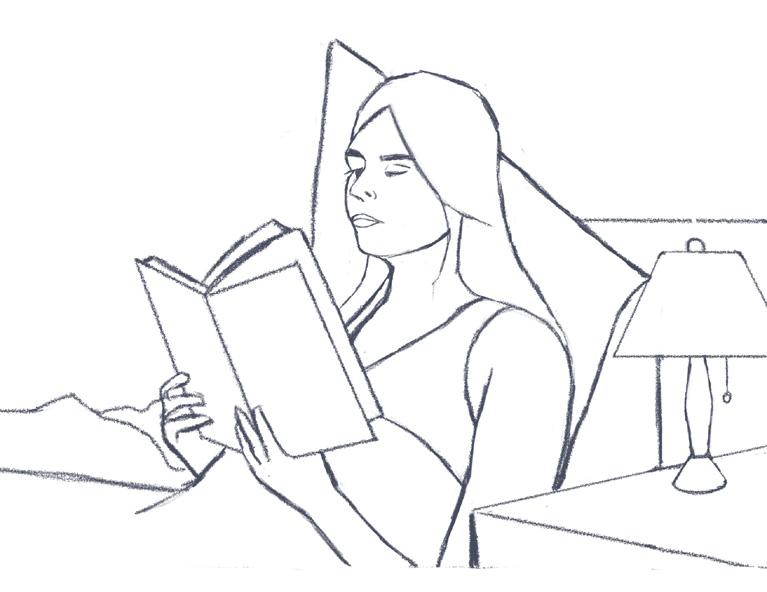 artwork by Madison Hoppler
artwork by Madison Hoppler
DECEMBER 1ST - DAY 4
5:00 pm - I was attempting to do my Psychology homework when I had the strong urge to lie on my bed and take a break. A lot of the time, I’ll use my phone as a distraction from something stressful to me, especially when it comes to home work. Without it, I had to push through and do my work, even though I thought it was going to be hard or stressful. Although I still found my mind wandering and searching for other ways to procrastinate, I realized that my phone has a large impact on my productivity. Not having it right next to me meant I didn’t have that immediate, subconscious dis traction. It allowed me to take a second to refocus my brain and attempt to get back on track.
6:00 pm - This day was the only day that I touched my phone during the whole week. My dad was adamant that I bring my phone when I went to volleyball practice in Hampton. He wanted to make sure he would be able to call me just in case I got in an accident or something else happened when I was driving home late at night. Even though my parents always scold me for being on my phone so much, they still rely on phones just as much as I do for communication. I decided to bring my phone in my car to keep my dad happy, but I told myself that I wouldn’t use it for music or directions. When I first grabbed my phone from the drawer, I immediately went to check if I had any notifications. I was shocked by my re flex to just tap the screen. Cunningham explained that many people exhibit this addictive type of behavior. “There are a lot of studies that show when we pick up our phones, we get a hit of dopamine. So, when we follow the pattern of picking up our phone and feeling good about it, we only want to do it more,” she said. I always understood this concept, but
it was surprising to see my dependency so blatantly. Although I knew it was completely shut off, the habit of checking for any notifications was so ingrained in my brain that I did it anyway.

DECEMBER 4TH - DAY 7
9:30 pm - My sister showed me something on her phone, and I saw all these unopened stories and posts on her Insta gram. It made me realize that people are posting and sharing things I hadn’t seen, and now I had missed out on it. This sense of FOMO was pretty hard-hitting. Without my access to social media, there was no way for me to keep up with everything that had happened all week. Social media is also a large part of how I learn about current events, and it was strange when I realized it was taking me multiple days to learn about important things just through word-of-mouth.
DECEMBER 5TH - FINAL DAY
12:30 pm - When I was going to retrieve my phone, I was surprised that I didn’t feel excitement or relief. Rather, I felt guilty because I had a feeling that I was going to slip right into my old habits and the experiment would be for nothing. Right after turning it on, I was bombarded with messages and notifi cations, and I spent over an hour catching myself up. This was frustrating for me because I was completely aware that I was doing it, yet I was doing nothing to stop myself.
 artwork by Madison Hoppler
artwork by Madison Hoppler
DECEMBER 2ND - DAY 5
7:45 pm - I feel like this was the first day where I started to acclimate to the no-phone lifestyle. At the beginning of the week, there were a lot more moments where I’d reach for my phone only to realize it wasn’t in my back pocket. Although it was only a few days later, I was more used to the idea of not needing my phone for every little thing. I think it helped that I still had my computer because it reminded me that I still had some way to stay connected. However, that doesn’t mean that I didn’t have trouble communicating. I sent a text on day three, and it didn’t come in on my computer until day five. Because of the delay, there was a disruption in communica tion, and it was frustrating that I wasn’t able to get in touch with the person as fast as I wanted to.
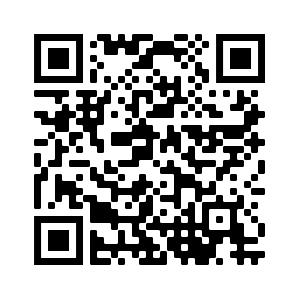
DECEMBER 3RD - DAY 6
6:30 pm - My friend and I were having dinner and she start ed checking her phone when there was a lull in the conversa tion. Cunningham said that when this happens, “it makes it really hard to feel connected with who you are with because people are not fully present.” I don’t blame my friend for this because normally in this situation, I would be going on my phone too. However, instead, I was just staring at the table waiting for something to happen. We could have been chat ting, laughing, and having a nice dinner together, but with technology in the mix, it was a lot harder to have a conversa tion and stay connected.
When I first told people about what I was doing, a lot of them looked surprised. “I could never do that,” they would say to me, shaking their heads. I’m proud of myself for be ing able to complete the experiment, and it felt liberating to know that I could live my day-to-day life without being sucked into a screen for 6 hours and 34 minutes of the day. It was also cool to see how I felt more satisfied with what I did with my day. Because I was more aware with how I spent my time, everything I did during the week had a clear purpose, and I didn’t feel bad about myself when I took time to relax because I wasn't mindlessly scrolling.
That being said, it was slightly disturbing to see how much my phone was ingrained into my daily life and how easy it was to slip back into my old routine. After this, I plan on finding more ways to reduce the amount of time I spend on my phone because I know it makes me feel better, and I encourage oth er people to do the same. If I was able to last a whole week without listening to Taylor Swift in the car, then I’m sure other people can learn to not have their phones on them 24/7 too.
Take this online quiz to learn more about your own phone usage!
- Lauren HopplerSaving the Planet One Shop at a Time
You may be wondering, “how can I help our beautiful planet?” I was wondering the same thing, so I decided to find some ways to incorporate sustainability into my life. The first step is understanding what being sustainable really means. Sustainability is when current generations are living to their fullest potential without compromising the earth for future generations. Sustainability does not just apply to the environment, but also to keeping social and economic stability for the future. What makes an item sustainable is de termined by its impact on the environment. If something is made out of synthetic fibers and will just create waste, it is not sustainable, whereas if an item is plant based or made of recycled materials it is sustainable. The next step is finding places that offer these items, which I went out and did for you. It is as easy as finding the closest shop to your house to start your sustainable journey.
We Fill Good
42
State Rd #101, Kittery, ME

This quaint little shop in Kittery, Maine off of Route 1 is home to all sustainable and organ ic products. Whether it be shampoo bars or refilling stations for all of your toiletries, they have everything one might need to start a sustainable lifestyle. When I walked in, I was greeted with large bottles of conditioner, laundry detergent, cleaning products, and even dry shampoo. These are all for customers to bring their own bottles to refill what they need in their households. While I was there, it was very hard for me not to drop a pretty penny on the products they had to offer. I bought a bar of soap with a loofah inside and a stand for my bar to sit on. I thought this was a great start to getting rid of the plastic in my bathroom. I decided to recycle my plastic body wash container and use the bars of soap instead to produce less waste. The bar of soap was only five dollars and the smell definitely sold me. Though, when comparing the detergent prices to the ones my family has bought previously, We Fill Good was pricier. However, the detergents and soaps are bought from other retailers such as The Fillaree based in Durham, North Carolina, that makes zero waste soaps. So really the extra money is going to the extra work to not use plastic. On my way out, I picked up the book “F**k Plastic” by Rodale Sustainability so I could learn more ways to help myself and to teach others how to be plastic-free. The store was set up so that each section of the store was for different purposes. There was a laundry section, a bathing and bath room product section, a baby section, and a kitchen section. To provide even more sustainability, they do not provide bags or receipts at check out so remember to bring your reusable bag EVERY WHERE. For those who are looking for a place to start their sustainable lifestyle at home, We Fill Good is the place to go!

Fair Tide Thrift Store
15 State Rd, Kittery, ME 03904
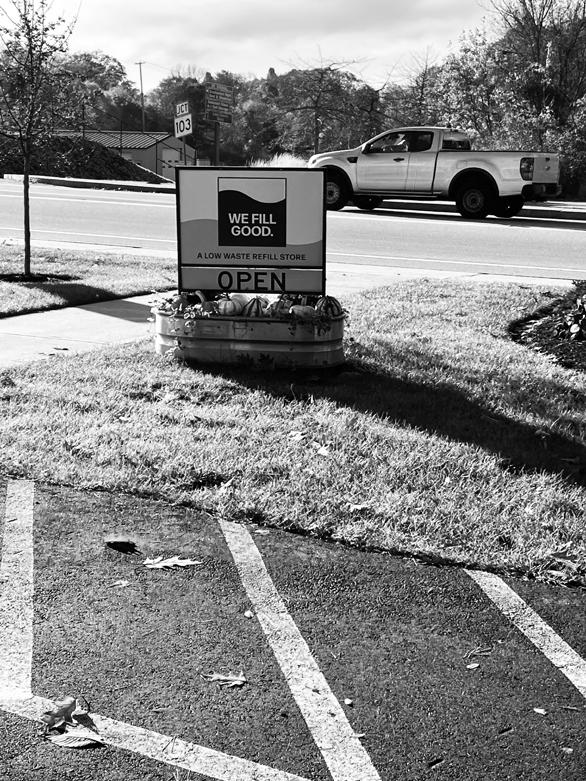
I found this shop on my way to We Fill Good. Their sign intrigued me when it said all their proceeds go to the Fair Tide Housing Program. The program is based out of Kittery, Maine and they own and operate a 5-unit house, and provide resources for those who are homeless. Inside, everything they sell is donated or made there. I found a vintage pair of Levi’s and a belt for fourteen dollars. The thrift store was large and had an abundance of items, so there was a lot to choose from.
I loved supporting this small sustainable business instead of going to the mall. According to “F**k Plastic” from Rodale Sustainability, clothing you buy from chain stores in the mall contains synthetic polyesters which make the clothing not biodegradable. Funding these stores with our purchases is a problem because they are causing pollution by just producing these products. According to the “UN Alliance For Sustainability” from UN Environment Programme, the fast fashion industry accounts for 8-10 percent of global carbon emissions. Buying from thrift stores helps to defund the fast fashion industry and prevent clothing from ending up in landfills.
The Drift Collective
12B Fleet St, Portsmouth, NH
This upbeat shop on the outskirts of downtown Portsmouth will not have you leaving emp ty-handed if you catch my drift! The clothing that they sell is upcycled or made out of recycled material. They have hoodies, tee shirts, crop tops, and bucket hats. I loved the vibe of this place. It has a very upbeat environment and it was hard not to buy everything I saw. Unfortunately, I did not walk out with anything because the items are a little pricey, with some of the sweatshirts ranging from 65 to 70 dollars. However, they do upcycle the items by hand which explains the price. Up cycling is taking old pieces such as clothing, furniture, etc and turning them into new pieces. You can actually see them sewing and making the clothing out back when walking through the store. I peered in through their beaded curtain for a few seconds to see some of the employees working on some sweatshirts. It was a cool experience because you know the clothing you are buying is not harming the environment or being made in unethical ways. To learn even more about the great things Drift is doing take a look at the past MOR article by Chase Amarosa “The Drift Collective.”


Revived Furniture and Home Decor
3
Rockingham Rd, Londonderry, NH
This store can definitely be mistaken for a Hallmark set. I took my mom and sister along for the ride with me because it is a bit of a drive. Let’s just say my mom was in home decor heaven. She left the store with a good amount of Christmas decorations. I personally loved how all the pieces had a rustic feel to them because of the small details that show their life before the store. Whether it be a scratch on the door or a chip missing from the leg, I always wonder where the furniture has been. Richard Leiter works on the pieces and not only revives the furniture, but he finds ways to take old items and create new furniture pieces. Finding used furniture is a great sustainable way to buy furniture and will help with having a sustainable lifestyle. When furniture goes out of style, people tend to just throw it away instead of donating or repurposing it. The United States Environmental Protection Agency (EPA) claimed that 80.2% of furniture produced in 2017 ended up in landfills. There are plenty of other great ways to dispose of your furniture such as donating to homeless shelters or organizations that accommodate those in need. You can also donate to Savers, Re-Store, or other thrift stores so the furniture has an opportunity for a new life. If a furniture piece is no longer your style, try to find ways on YouTube to revive your furniture yourself. On Revived’s website, you can find behind-the-scenes articles on their furni ture collection which can also help spark inspiration.

The Spice and Tea Exchange 3 Congress Street, Portsmouth, NH
For me, this was one of those shops that have always blended in with the hustle of down town Portsmouth while walking by on my way to my favorite pizza place or to buy a new top. However, immediately when I walked in, I did not want to leave. I was taken aback by all the aro mas of the spices and teas blended together, and I loved seeing the minimum plastic packaging for the spices as well. According to the EPA, packaging makes up 45% of landfills, whether it be food wrappers or plastic from toys. There is nothing else we can do with the packaging after eating or opening it other than repurposing it around your home or throwing it away. So, finding ways to re duce or even eliminate the packaging you are using is a great way to live sustainably. The Spice and Tea Exchange (TSTE) offers containers with all their spices that can be used to refill old packaging. They do have prepackaged spices and teas, but you can always refill those packages afterward. They also offer teas and spices that have health benefits such as boosting metabolism and reducing inflammation. So, you can help your body while helping the earth.
I spoke with Toni from their internet fulfillment team about the origin of their teas. Their spices and teas come from all over the world and their website provides each item’s origin country. The spices they have may be on the pricey side, but it is beneficial to know where all the ingredients are from. For example, if I buy a Pumpkin Pie Spice from TSTE for a 1 oz bag it would cost $5.49, whereas if I buy a 1.4 oz from Shaws from the brand Organics it would cost $2.99 for an even larger amount. As I have noted before, shopping sustainably costs a lot more than buying fast fashion or buying from a box store. This is because sustainable products take more time and money to create, resulting in a higher retail price. Unfortunately, the cheaper and easier to make products are ruining our environment, which is why, again, it is so important to find a sustainable way to shop.
Ten Thousand Villages 87 Congress Street #104, Portsmouth, NH
This shop reminds me of a fair in the best way possible. It is one of those shops that you never really know what you will find and is a great spot for gifts. They have such a variety of items like handmade items from India, Kenya, Columbia, and many more. Just a few of the handmade items that they sell are scarfs, coin purses, earrings, and tea towels. Selling items made by hand from other countries is a great sustainable practice. Knowing the sources of your products helps you note the suitability of the items. Buying from those who hand make their items helps to reduce the amount of carbon emis sions that companies are producing. This is a great place to purchase gifts that help benefit fair trade and don’t support mass production companies that harm the environment. You may be wondering, what is fair trade? Fair trade means the business makes an agreement with the producer or maker that benefits both parties. So, there is a fair price agreement and the prod uct is made by someone who will truly benefit from your sale. Ten Thousand Villages focuses on purchasing goods from communities that are impoverished and are struggling. The people making these items are being treated fairly and are in good working environments unlike the conditions workers for fast fashions brands work in. It is important to recognize the difference between an item that is labeled “hand made” and an item that is labeled fair trade. A “hand made” item does not necessarily mean that it was made ethically.
After my multiple day-long shopping journey, I was left thinking, “how can I sum this up so others can start their own journey?” I decided to make a list of how I have learned to live sustainably. So, read the list, grab your coat, and make your way to the store.
Emily’s Ten Ways to Shop Sustainably:

1.) Bring a reusable bag with you EVERYWHERE you go
2.) Invest in a water bottle and ditch the plastic ones
3.) Bring cloth bags for your grocery store fruit
4.) Buy biodegradable or reusable cotton swabs, flossers, make-up wipes, e.t.c.
5.) Buy a stainless steel razor, not the disposable ones

6.) Buy used clothing to avoid funding the fast fashion industry

7.) Bring a reusable cup when you go to cafés
8.) Opt for no receipt or have them emailed
9.) Re-fill your shampoo, conditioner, hand soap, and other toiletries
10.) Read “F**k Plastic” by Rodale Sustainability to learn 101 ways to ditch plastic

Now, after reading the list it may have raised a few red flags. One is “how the heck am I going to pay for all this?” Shopping sustain ably, though very helpful for our planet, can be damaging to our wallets. One of the biggest concerns for those wanting to start a more sustainable lifestyle is the price of sustainable items. I won’t hide the fact that when I came home from my sustainable shopping day, all I had left in my wallet were dust bunnies. However, every little bit helps, whether it is picking up a plastic bag on the sidewalk or just starting small and buying a plastic-free bar of soap instead of a bottle.
Everything comes with downfalls and for shopping sustainably, it’s how expensive it is and that not every store has sustainable items. When shopping I did notice that everything I needed was not all in one place like it is when I shop at Target. When I got home I was still greeted by lots of plastic around my house. I wasn’t able to buy everything I needed sustainably and there is still waste being pro duced from my house. I still think we have a long way to go in every industry to have fully sustainable lifestyles. Though, to make some sort of impact on the world around us, we don’t need to ditch our current lifestyles entirely. Do what’s right for you and your family. Even going out and buying a .99 cent reusable grocery bag is a great place to start your sustainable journey. You could even be help ing more than you know. By using your reusable water bottle you are creating less plastic waste or by being trendy and having a thrift sweater, you’re helping to defund the fast fashion industry. No matter how or where your sustainable lifestyle starts, we all need to work together in order for the planet we call home to stay the beautiful place it is today. As the Lorax says, “unless someone like you cares a whole awful lot, nothing is going to get better, it’s not.”
- Emily JackmanThe Best of Bad Parking
At the time of writing this article, ORHS bad parking was the only Oyster River affiliated school account that many found humorous. However, since then, many other Oyster River accounts have been created invading many students’ privacies. These accounts have been taken down while ORHS bad driving remains since it was deemed appropriate.

“@orhsbadparking requested to follow you.” As someone who is horrid at parking, I felt personally called out by this Instagram notification.
Fortunately, there happen to be many others like me who are terrible at parking, giving rise to the new Instagram page, ORHS Bad Parking. This new Instagram is dedicated to Oyster River student drivers who are caught with particularly awful parking jobs. Students take pictures of any cars they see with a wacky parking job and submit them to the Instagram page through a Direct Message, then the photos get posted. The comments of these posts include playful teasing, tagging the car’s owner, and other comedic re sponses. The page receives sub missions frequently and students who get posted get a good laugh from it along with their friends.
Inspired by a TikTok on their For You Page, the creators of ORHS Bad Parking launched the Instagram page in early Septem ber. Since then, they have accu mulated over 400 followers. The creators were initially shocked by the support they received from the student community and said, “we honestly did not expect it to gain any attention, especially not the amount it did.”
The creators have been enjoying running the page. “It’s been fun. It can be a little stressful to stay anonymous. Besides that aspect, it’s been an entertaining experience so far.” Adding to that, they said, “it’s even more entertaining to see people react to the posts and try to figure out who we are.”
Those who have been featured on the page tend to have backstories explaining their terrible parking. Addie Berglund (‘22), who has gotten posted on the page, not only had a bad

parking job, but also had an incident beforehand. She explained that she normally parks in parallel parking spots by just driving into the spot. However, due to the crowd that morning, she was forced to do a back-in park job. As Berglund was backing up, the car behind her didn’t realize she was trying to park and honked. However, it was too late and she hit the car.
Afterwards, Berglund was already late for school and fran tically parked into her normal spot. However, she didn’t have time to properly adjust her parking, and someone submitted a photo to the bad parking Instagram. She said, “it was kind of frustrating at first, but I kind of knew it was going to happen. After I saw myself on [the Insta gram], I started thinking about who might have sent in that picture. My parking was awful… half of my car was on the grass.”
Audrey Sigmon (‘23) was also featured on the ORHS bad park ing instagram. Like Berglund, Sigmon found amusement in the post. She explained, “I have my own spot that I go to school ear ly for because it is the only spot I feel comfortable to park in. It is the one in the tennis court lot right in front of the giant yellow pole.” She continued, “on their page, it looks like I was touch ing the pole to my car which I literally may have been since I hit that pole probably twice a week. I am so close to buying a pool noodle to tape to it so my car won’t have as much yellow paint on it. I wasn’t embarrassed to be on [the Instragram]... I thought it was so funny and everyone who usually parks near me knows it’s me and has probably seen my car bump [the yellow pole].”
In general, Sigmon gets a good laugh from all the posts on the instagram page. She said, “I think it’s hilarious. The owner is doing a good job keeping the cars censored [by editing over the license plates] in case people get embarrassed.” Along with this, the owner of the account mentioned they censor the cars for privacy.
Matteo Caruccio (‘22) agreed with Sigmon and said, “I love seeing ORHS bad parking material. I’ll be scrolling and judging everyone’s bad parking jobs. It’s especially funny when you see someone you know because that’s the first thing you can bring up when you see them.” He continued, “it’s almost like a naugh ty and nice list, except ending up on the naughty list is funny.”
While Heather Clegg (‘22) agreed with Caruccio, she also said that the account can cause anxiety when she is parking. “It’s funny to see other people on there, but personally I definitely do get anxiety about being featured. I would fix my parking or make sure I’m parked in the right spot and make sure my car is straight so I wouldn’t end up on there.”

Clegg continued and brought up how certain types of posts on the page can be unamusing. She said that “the page is extra funny when you see your friends on there, but sometimes it’s not that funny when you can see that the cars are parked badly intentionally, like when they run over huge curbs or tree stumps… it’s not funny when it’s staged.”
While the majority of students find the ORHS Bad Parking page hu morous, Kevin Towle, a driving instructor, thought differently. He said, “if
your vehicle isn’t situated in a good spot as you go in [to a park ing spot], it’s going to be tough to get out. So it may be funny when you walk by someone who is not parked too well, but you gotta wonder what type of trouble they are in when they try to leave that parking spot.” He continued, “you gotta think about the damage when you park too close [to another car]... of course you’re gonna put dents and marks on people’s cars.”
To improve student parking at ORHS, Towle continued to give his advice. “The big prob lem is that kids are rushing to get to school and to get inside and they don’t take their time to work on parking well… it doesn’t really take a lot to be good at parking, it just takes a little bit of time and thinking.”


More specifically, Towle said, “when it comes to the ac tual parking, you want to stay as far away as you possibly can from where you are parking because that’s going to give you more time and more distance to make corrections.”
ORHS Bad Parking has been entertaining for many but the effects of bad parking can be damaging and possibly even dangerous according to Towle. As the snow season has ar rived, Towle advised students to become more aware and cautious with their parking. As someone who has been featured on ORHS bad parking twice now, I know I will be more patient with my parking going forward.
- Bhavana Muppala“It’s almost like a naughty and nice list, except ending up on the naughty list is funny.”Photos from @orhsbadparking Instagram
The LGBTQ+ Community and Social Media
According to a study posted by GLSEN in March, 2021, 44.9% of LGBTQ+ students reported being cyber bullied. The LGBTQ+ community is made up of people with a sexuality, gender orientation or identity outside of straight, cisgender, or someone questioning any of those things. Specifically for members of the LGBTQ+ community that may not get represented in other types of media, social media is a particularly important resource. It can be a place for freedom, exploration and reprieve for members of the community who may not feel accepted in their in-person environments. However, using something with so many diverse perspectives can lead to a confusion between information and misinformation.
One way social media can be beneficial is that it helps transgender people through their transition ing process because it allows them to share their identities to an extent that would not otherwise be possible. Oyster River student Thi Udomprasert (‘22) says, “there are a lot of ways trans people [use social media to present their identities]. . . A lot of
people may choose to present themselves [in] a way that might not be entirely realistic, but is reflective of where they would like to be in their transition.” This can be a powerful and effective way for transgender people to express how they would like to be seen and share that with other people.

However, while some people are able to identify and share their labels, for those who are unsure of how they identify, being exposed to other people who do know on social media often adds pressure rather than relieving it. According to Udomprasert, “people take a lot of pride in their various identities . . . I think the problem with that is it creates a sense of pressure. There’s a pressure to say ‘I am this.’ It uncomplicates it and makes it more simplistic but then people have to wrestle with ‘what if that is not right [for me].’” The need to simplify and identify things is a basic sociological trait of human beings, but when this starts applying to people and groups of people, it can be confusing and compli cated. Despite stereotypes, there is no one way to fit a certain label and that can look different for each individual.
Social media can also make it challenging for LGBTQ+ people
to separate accurate information from false information. Ac cording to Udomprasert, “social media is a great place to spread information, [however], there’s information and then there’s mis information. So it really is a conflict between reality and a wierd, bigoted perception. I think that’s really challenging to navigate because it’s really confusing and complicated.”
Misrepresentation and misinformation can mean a lot of things to a lot of groups. One form of misinformation is stereo types. For the LGBTQ+ community, it is rooted in stereotypes and invalidation by a large portion of society and how these influence how they are received by friends, family and peers. An example of a common misconception or stereotypes is that often seen in the comment section of peoples posts is bisexual women are just confused straight women and bisexual men are just gay. These
can be hurtful and invalidating for a member of the LGBTQ+ community who is trying to share their identity with the people in their life because these stereotypes and misconcep tions can shape how the people in their life feel about them after they come out and how seriously they are taken.
stereotypes
“These stereotypes probably wouldn’t be as pertinent to my identity if they weren’t perpetuated on social media so much, but since [the stereotypes] are there all the time a lot of people can see them and a lot of people believe them. It [makes] it easier for people to generalize a certain group of people if [stereotypes] are being reinforced by social media.”
While it isn’t inherently negative, social media can lead to the perpetuation and formation of stereotypes that can impact how queer people present themselves online. According to Oyster River High School student Tess Parrott (‘22), “these stereotypes probably wouldn’t be as pertinent to my identity if they weren’t perpetuated on social media so much, but since [the stereotypes] are there all the time a lot of people can see them and a lot of people believe them. It [makes] it easier for people to generalize a certain group of people if [stereotypes] are being reinforced by so
use the term LGBT and we use [the letters] as markers for distinct identities. There are lesbians, gay men, bisexuals, and then the transgender people [and] they never intersect, but they often do. That’s more of a cultural language [problem], but is a stereotype too.” This can be problematic because it leads to a lot of stereo types and confusion for people as they try to figure out who they are and what labels they fit.
Coming out in general can be challenging without the added pressure of social media. However, with the abundance of knowl
cial media.” Often people can control what they see on their feeds, but how can you dismiss something you don’t know is wrong?

Oyster River High School student Qrow Tzizik (‘22) says, “I try to curate what I see on [social media] and who I interact with to those who I know are supportive [of my identity].” So while in some cases curated, or heavily censored, feeds can work to perpet uate stereotypes and spread harmful messages, in others it can be used to protect yourself from them.
Lack of information can also be a factor in how someone iden tifies and how they are received. The confusion of conflicting or missing information can even lead to not having the knowledge and vocabulary to accurately identify your identity when you first
edge social media offers, it can actually help some people find and share the identity that fits them. Udomprasert says, “social media helped me to come out, but it didn’t force me to. It isn’t necessarily a negative thing for queer kids. It can be, [but] I think it’s ulti mately knowing where to look [and] knowing what hashtags are attached to the representation you’re looking for.”
Social media can have all these negative aspects but it has also had some positive impacts on the LGBTQ+ community. Parrot says, “social media has given people a platform to explore and express their identity in a place where they can’t be hurt for it. It gives a community which is really important and gives sup port where you wouldn’t [usually] be able to find it.” It can also
come out. This can work to undermine the LGBTQ+ community because some people perceive someone changing their label as the person changing their mind, when really they just didn’t have the correct vocabulary. Parrott had a similar experience, “I came out as bisexual because I didn’t know what pansexual was [when] I was in the eigth grade.” To be completely clear, there is nothing wrong with changing your mind or realizing that you more close ly identify with a different label then when you first came out.
Another aspect of social media and the stereotyping is the pressure from within the LGBTQ+ community to find a label and fit a certain way in the community itself. Udomprasert said, “we
be a place of pride for LGBTQ+ members. Oyster River student Isabella Noccetti (‘22) says, “social media allows us to be proud of ourselves when our in-person environment might not allow us to.”
With all social media’s positives and negatives, one can’t really say whether it is harmful or helpful in the perpetuation of stereo types of the LGBTQ+ community. This is best said by Udompras ert, “the LGBT community is so diverse that there are stereotypes that can and do form, but ultimately you don’t want that because there is no one way to be.”
“I try to curate what I see on [social media] and who I interact with to those who I know are supportive [of my identity].”
“Social media allows us to be proud of ourselves when our in-person environment might not allow us to.”
- Annie Doherty Art by Gabby Lowery
Fitness Journeys
Was your New Year’s Resolution to work out more? For some Oyster River High School students, working out isn’t just a resolution, it’s a routine. If you were to walk into a Planet Fitness after school any day, it would be packed with students from ORHS. There have also been accounts popping up on Instagram where ORHS students are sharing their fitness journeys. For many, working out is a great way to be physically active and also achieve personal strength goals. Along with gaining physical strength, many have experienced men tal health benefits they never would’ve expected. Continue reading to hear ORHS students share how they started their process, what they’ve experienced, and their advice for people interested in starting their fitness journey.
Angie Morse
Angie Morse (‘22) said she began working out when she “started going [to the gym] with [her] mom’s boyfriend just for fun.” Then, when she stopped playing basketball, she “just started going because [she] wasn’t doing a sport and wanted to stay active.”
At the beginning of her fitness journey she said, “I got really into it watching other people on Tik Tok and Youtube. I learned everything I know from Tik Tok and social media so they definitely inspired me.” She herself has an account she created over the summer when she had free time and posts videos of her work outs, progress pictures and occasionally food that she eats.
Morse noted how many social media accounts encourage working out to lose weight or restricting your diet. She disagrees with this and said, “when you’re eating healthy, it makes you feel better and you’re more motivated. When you eat more and have more energy, it’s actually easier to work out.”
Morse also explained how working out is very positive for her mental health. “I like going [to the gym] alone because it’s a de-stressor. It’s my time away from social settings. After you work out, it releases all the endorphins and it just makes you feel better,” she said.

Her advice to people looking to improve their mental and physical health through fitness is to “find people [on social media] who put out the right message for working out.”
Follow @angiemorsefit on Instagram for more!
Nic BrownNic Brown (‘24) has been working out for about a year. He explained that the reason he started working out was that “I was over weight as a kid and just kind of wanted to end that.” He continued, “I started by doing cardio, going on the treadmill for 30 or 45 min utes a day. Then it kind of changed into weight training as I started to go [to the gym] more and more.”
Brown works out at Planet Fitness and commented on the number of ORHS students he sees there. “I go with my friends sometimes, but most of the time I end up seeing at least someone I know there,” he said.
For Brown, working out has benefited him both physically and mentally. He plays baseball and working out has helped with get ting him stronger for that. He also agrees with Morse’s point about mental health, and said, “it helps my mental health too. It helps me relieve stress.”
His advice for others interested in starting to work out was “to just go for it. Start with some low intensity training, maybe three or four times a week, and if you enjoy that, you can up it from there. Make sure to do what you like in the gym because if you aren't doing what you like, you won't keep doing it.”
Bryce Harmon’s (‘22) fitness journey began last February and he has kept going with it ever since. He said, “I started doing track and field and [that] kind of sparked me getting into lifting and getting stronger. When I started seeing progress, it just boosted my reason to continue with it.”
Harmon created an Instagram account in June to document his process and share it with others. He posts videos of workouts and lifts he does as well as progress pictures of his growth and strength. “I like to share because I started off chubby and weak and now I’m a lot stronger… [posting my progress] builds confidence for me.” Harmon gave an example of recently hitting the 1000 lb club and said, “I felt like that was a really cool thing to share.”

After working out consistently for almost a year, he has experienced times where he doesn’t feel as motivated to keep working out. He shared how he gets this motivation back: “I sometimes lose my confidence [or I won’t] be feeling it one day, but then I just stop. I’ll be like ‘alright, I’ll get back on this another day.’ [That feeling] usually just leaves and then I’ll be like ‘looking good Bryce’ and feel like I’m going to do better this time.”

Harmon’s advice to people experiencing that same feeling or just starting their fitness journey is: "don't give up because you [haven’t made progress]. Eventually you will see change in yourself if you keep working at it" Follow @brycesprocess on Instagram for more!
Nadia Janetos
Nadia Janetos (‘23) works out a bit differently than the other students men tioned above. She started doing barre at the end of the school year last year. She described barre as, “a ballet thing because there is an actual bar where we do [ex ercises.] We have weights, bands, ankle weights, balls, we do everything. It's kind of like pilates, yoga, cardio, abs all mixed into one.” She started doing it because, “I decided I wasn’t going to do basketball this year and I was like, ‘I need to find something to work out with and burn off all of my energy.’”
She enjoys doing barre for many reasons, one being the positive energy. She said, “it's a bunch of moms and college students which I like because then I don’t have to see anybody I know from school. It makes me feel less self-conscious.”
Janetos also uses working out as a stress reliever like Morse and Brown. She said, “I’m a very anxious person, and barre has been the only outlet that helps me. When I’m anxious and I do barre, it goes away. It feels so good because I’m just in my own mind focusing on the workouts,” she said.
Janetos strongly encourages others to try barre and working out in general. She said, “I’m surprised I’m that person who wakes up at 5:00 am to work out but it's amazing. It makes you feel incredible. It feels like I accomplished something today and it's such a healthy outlet when I have stress from school.”

Each person can find their own health benefits to exercise, whether it's gaining strength, easing anxiety, increasing confidence, or something else. The possibilities are endless for what working out can do for you. Maybe for this year, these people have inspired you to incorporate exercise into your routine!
- Libby DavidsonCookin’ Up the Championships
Over the last couple of seasons, Oyster River High School sports have had many firsts, including the first time ever win ning the championship for three sports. In total five teams have received the award of state champions including softball, Unified volleyball, golf, girls cross country, and Unified soccer. These wins were all monumental, not only for the teams, but for the school as well.
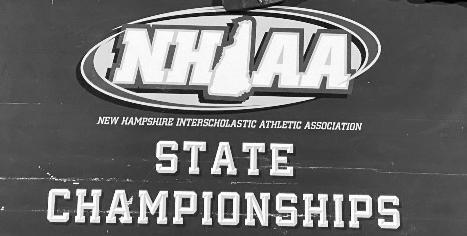
It is important to recognize each sport at Oyster River High School and acknowledge their accomplishments. Each team has worked incredibly hard to get to the point of winning a state championship and can now relax and celebrate all that they have done. The MOR staff wanted to recognize the major accomplish ments that Oyster River High School athletic teams have gained over the past year due to the many firsts that have occurred.
Softball
Last spring, the softball team won their first ever championship. Gracie Gagne (‘22) who plays center field, second base, and pitch er, describes the feeling as “...unbelievable. Words cannot describe how happy I was for my team to win this. I know I have always wanted to win a state championship in high school and I was very glad it was with the team I did it with.”
The game was one of their best played, staying in the lead the whole game against Milford. Morgan Veno (‘22) who plays outfield, says “there have been articles about our hitting early on in the season but towards the middle end it sort of plateaued. We barely made it through the playoff season going into overtime and only winning games by one run. In the final game we saw all of our hard work really show. Everyone had such a high level of ener gy that it made us all play to our absolute best and it paid off.”
With the season being different due to COVID-19, the softball team had to play the different teams around us. They faced off against many D1 schools, making our team better and stronger for the playoffs. In 2019, they made it very far, only to lose in the quarterfinals and then not having a season the 2019-2020 school year due to COVID-19 just hitting hard, they had the drive and the perseverance to go far and win the state championships.
Growing from a softball team that was on a losing streak to winning the state championships changed the attitude towards this sport. “I think it changed something for the softball team. They used to be very bad and used to get made fun of in school for play ing softball… but now we changed the program to what it is today
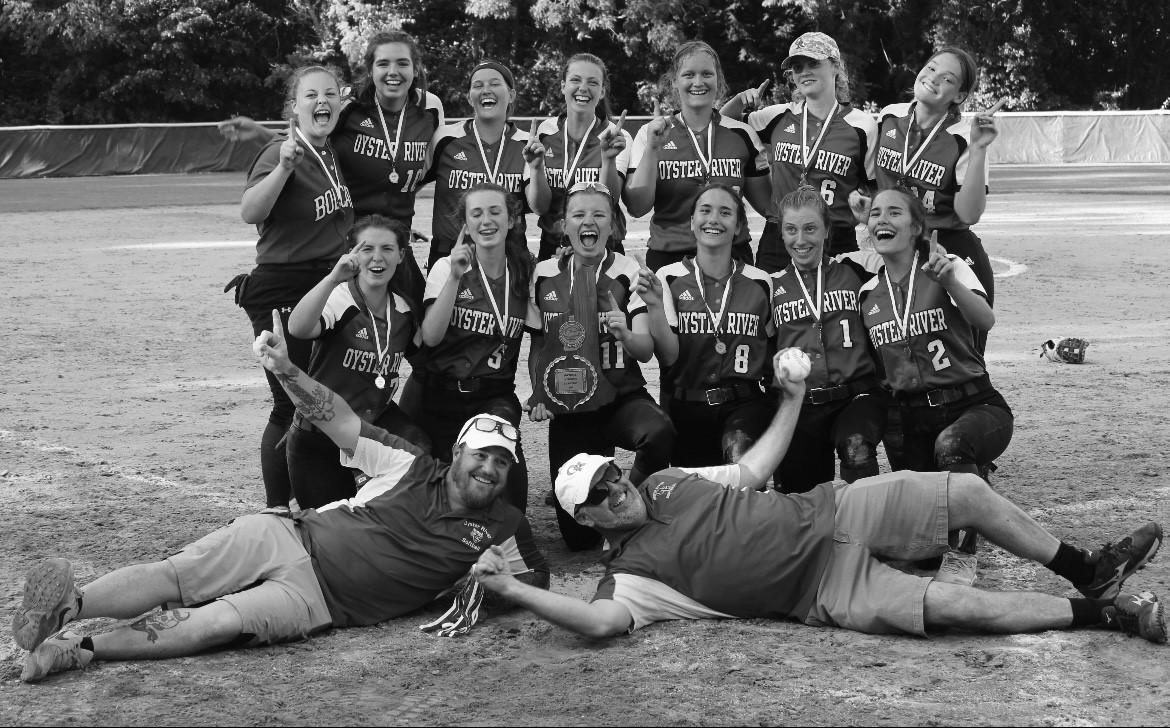
and I hope it keeps going up from here,” says Gagne.
Now this year, for the spring season, they are excited to be back. Although they won, they also have to think about losing some of their best players. “I think we can keep up our offense which is hitting. We had a great hitting season last year and I think we will have another one. We also lost five important seniors and it’s gonna change our whole defense, so [that] will be a big change this year and something we will need to work on,” says Gagne.
Unified Volleyball

Also winning their first ever championship this spring, the Unified volleyball team persevered through their season and were able to win a state title for Oyster River. Annika Baumgardt (‘23), a partner, says, “it was so amazing to win the championship. There was so much excitement and energy from the team and the fans [during] the whole game, and when we got that last point to secure the win, the gym exploded with cheers. It was so emotional and overall such a proud moment for everyone.”
Alexander Satterfield, the Unified volleyball coach says, “it was the first time Oyster River had won a championship in Unified sports, so that was pretty cool.” Finally winning the championship over Dover, who won in 2018 and 2019, was very exciting and with this new accomplishment, more people have been involved with Unified sports. “I definitely think it changed something at Oyster River. I think everyone can agree that over the past two-ish years, Unified sports have really grown in popularity. They’re a really amazing way to bring everyone in the school together and the bonds that the players on the team form with each other are amazing. I really hope that Unified sports continue to thrive at Oyster River,” says Baumgardt.
For the spring season, they are enthusiastic and ready to keep the title. “The most important thing for us is keeping the energy up when we’re playing. We’re all so supportive of each other which is something I hope stays the same next season…” says Baumgardt.
The golf team winning the championship was another huge moment for Oyster River. “It was a really great feeling!” says varsi ty player Delaney Nadeau (‘24). She continued, “I was the last per son to post the score which ended up securing it for us, so I didn’t experience the waiting that other people did… our team also had worked very hard through the year despite a variety of challenges. It was also a rewarding moment, as our coach was battling some health issues, and we had played the last bit of the season as well as worn ribbons in support of him that day which made it all the more special.”

The tournament was very well played, with the Bobcats win ning by 9 points. Nadeau says, “I think probably the fact that it wasn’t the top few kids that won it, but a combination of everyone that made it really special. Playing for our coach also changed the dynamic and brought the team together a little bit.” With the golf coach recently battling some health issues, the team played their best for him, and even wore ribbons in their support.
“Next season will be a year of growth for the team as well as the program in general. The dynamics will also be different as I likely won’t be the only girl on the team and it will be interesting to see if that has any effect on things,” says Nadeau. The next season will be very different for the golf team, with only two players returning. “Next season will see a drastically different lineup and potentially a new coach. Delaney Nadeau and Myles O’Quinn are the only returning [varsity] players and their experience will help guide the new players to hopefully another championship,” says Jack Poitras (‘22) a varsity player.
Girls Cross Country
seeing our fifth runner come in and just knowing before we had a tally that we had won states was really cool.”
The entire varsity team this year was made up of underclass men, which is uncommon for a high-intensity athletic team. “... I realize the potential we will have once we gain more experience,” says Brown. She continued, “for next season we want to use what we’ve learned this season since we’re all so young and the experi ence will be really good to have behind us. We try to pack togeth er as much as possible and have the smallest difference between our 1st and 5th runner so that’s another goal for next season.”
Unified Soccer
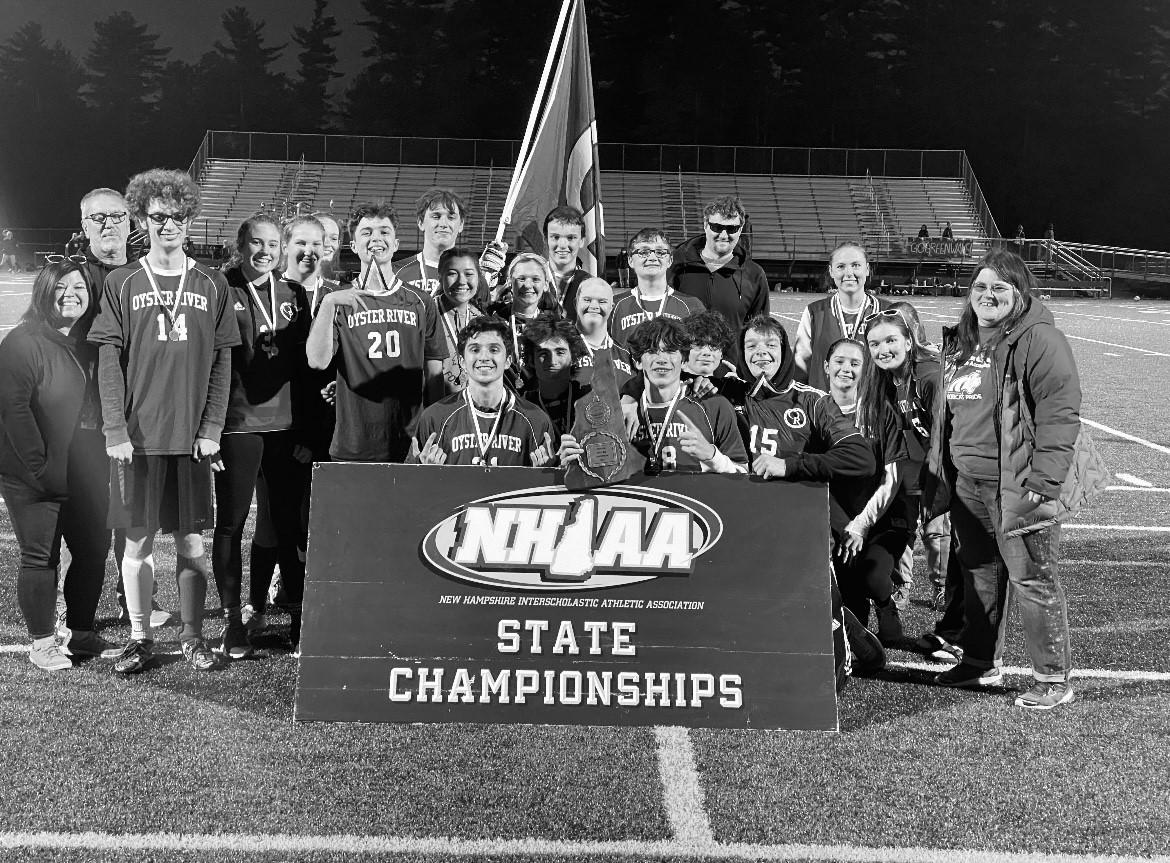

For the first time in 22 years, the girls cross country team won the state championship this past October. Tessa Brown (‘24), a varsity runner, recalls, “we were almost in shock after winning states [and] it felt so amazing. We were all really proud of each other and that energy was contagious.”
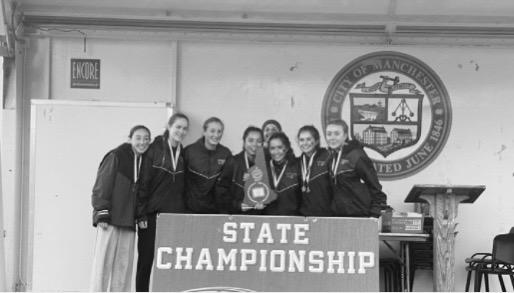
Nicole Toye, the coach for the girls cross country team says, “basically how cross country works is that you score the top 5, so
Lastly, the Unified soccer team won their first ever state cham pionship this November. Mitchell Warden (‘23), a player, says, “I felt happy for myself but also the entire team and the school because this was the team’s first ever championship win in [Oyster River] history for Unified soccer.”
After beating the number 1 seeded Exeter in the semifinals, the Bobcats, as the number 3 seed, were confident in their victory over Dover in the championship game. “We had never beaten Exeter as a school in Unified. I think that everyone felt the energy and committed to our game plan and I think that gave us the belief that we could win and for the championship game as well,” says Satterfield, the Unified soccer coach.
The game happened only a couple of days after the boys varsity soccer team lost in their championship game to Lebanon in penal ty kicks, so Warden believed that the Unified soccer team owed it to them to win. “I think the win changed a couple things for Oyster River. The boys varsity had a great season but lost a heart breaker in the finals, and we did this for them…” says Warden.
For next season, the team plans to grow and get better to keep their title. “Although we will lose quite a few to graduation next year, I think we will still be capable of winning games and making a deep playoff run again as long as everyone on the team can get along and communicate well with each other on both sides of the ball,” says Warden.
It will be exciting to see where all of these teams go in their next seasons, especially now that they are state champions. Each team and individual player has worked hard to get to the position they are in today and I know I speak for all of the Oyster River community in saying that we are proud of them!
- Caitrin FerrisThe Saga of Satterfield
Three sports, two championships, one man, and his name is Alex Satterfield.
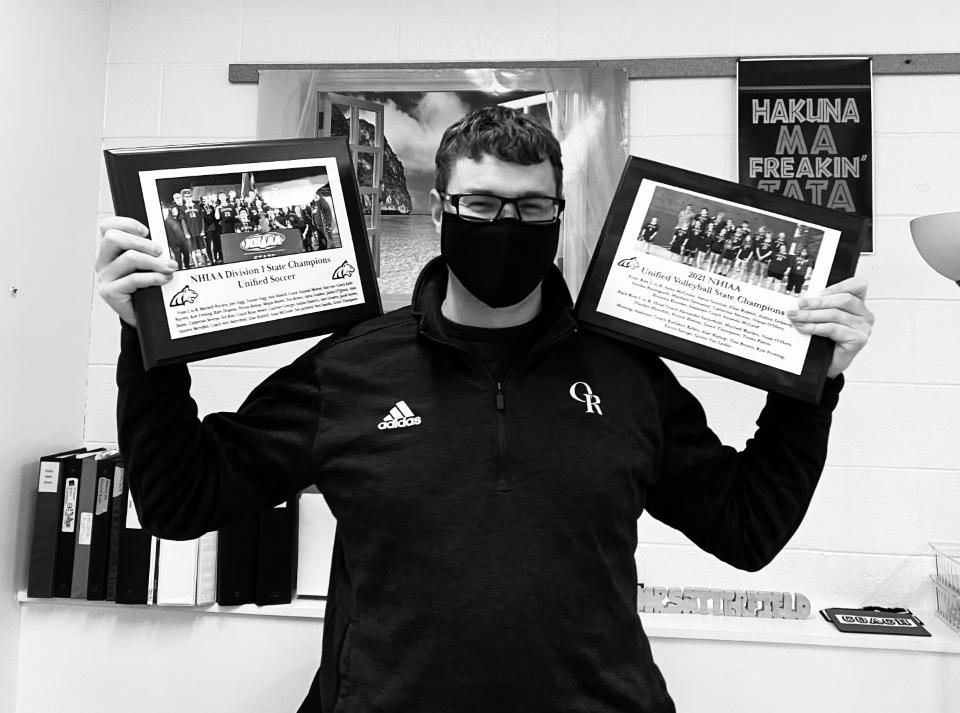
Alex Satterfield has worked at Oyster River for the past eight years. In those eight years, he has not only inspired students, coworkers, and everyone around him, but also coached three Unified sports teams all school year. This November 2021, the Unified soccer team went up against Dover High School in an intense championship game. While Dover played well, Oyster River took home the Unified soccer championship for the first time in Oyster River history. In the year 2021 as well, the Unified volleyball team won the state championship against Dover.
Satterfield started his career working with the Oyster Riv er Unified teams’ rivals, the Dover Green Waves. However, Satterfield’s passion for helping others dates back even further. “I had a friend growing up that had Muscular Dystrophy, and so we always had to do things a little differently, which is kind of something that I liked. I liked the challenge of figuring out the problem and the coming up with a solution that worked out.”
Satterfield spent five years at Dover High School as a Spe cial Educator and the idea of finding solutions resurfaced when he discovered the program of Unified sports in 2008. “Unified really did not exist [at Dover before]. I was the first coach that started it at Dover. There wasn’t another program before that, so it was just kind of up and coming...but now it’s really taken off.” Even if he did not create the program, without Satterfield, it might not be as big of a deal as it is today. “I was a part of start ing the program. You know, you need a coach to have a team,” jokes Satterfield.






Once Unified was introduced to Dover, some sports stayed while others went. “Unified soccer was the first [sport] that came about and Unified Basketball followed pretty closely after that. There was a Unified track and field team that started up in the spring session, and then that changed and then became an op tion whether it was Unified track and field or Unified volleyball.”
When talking about the different sports, Satterfield mentions his love for Unified volleyball and why. “I definitely prefer the
volleyball. I think that the volleyball is just the epitome of what Unified sports should be because everyone can do everything. Everyone can hit the ball over the net, anyone can pass [the ball] to anybody, anyone can score a point which I like because I think it just promotes that inclusivity even more.”
When starting the Unified program at Dover, only 12 people joined the team, a number which has now doubled this past 2021
Moody also talks about how Satterfield was able to make smart and strategic decisions when it came to different components of the game, such as subbing. “I know Unified isn’t all about win ning, but the teammates want to win and so I think that he put a lot of thought into that this season.”

Alex Gruden (‘23) first learned about Unified teams when he moved here this year. He joined Unified Soccer and so far, he has
Unified soccer season here at Oyster River. This could be for many reasons, but to the students of Oyster River who participate in the Unified sports, they chalk it up to the amazing coach who has taught them along the way. Satterfield was very humble. “I would say the students make up the team and the program. I create the framework and with great partners and facilitators of the different activities brings great results and relationships between students... It really is who is involved in the program [as well], that’s why it’s important to get quality partners who are dedicated and support ive and there every day working hard, sacrificing to really make it work.”
While Satterfield was not wrong about the amazing partners who work on these Unified teams, helping and supporting, they also owe a lot of the team’s success to Satterfield and the amazing coach he has been. Megan Moody (‘23) returned to Unified soccer this year as a junior after previously playing her sophomore year. Last year was the first time she had met Satterfield and he made sure to make a good first impression. “He was just a super nice guy. He has a good sense of humor and he just wants the best for everyone on the team.”
liked the friendly environment that the team offered him. “I think [Satterfield’s] attitude positively affected [the team]. He was able to motivate us.”
Satterfield’s impact on his teams is not just noticed by the stu dents who played for him, but also by the staff. Andy Lathrop is Oyster River High School’s Athletic Director. Lathrop has known Satterfield for five years now. They started at Oyster River together and immediately Lathrop brought him on to coach the Unified sports and clearly, that was the right choice. “The players love playing for him. I think he just has a great temperament, he takes it seriously but also knows when to have fun. I think the players enjoy coming everyday and enjoy being around him.” Lathrop continues his compliments on Satterfield saying, “He helps to create that energetic vibe at the games and the practices.”
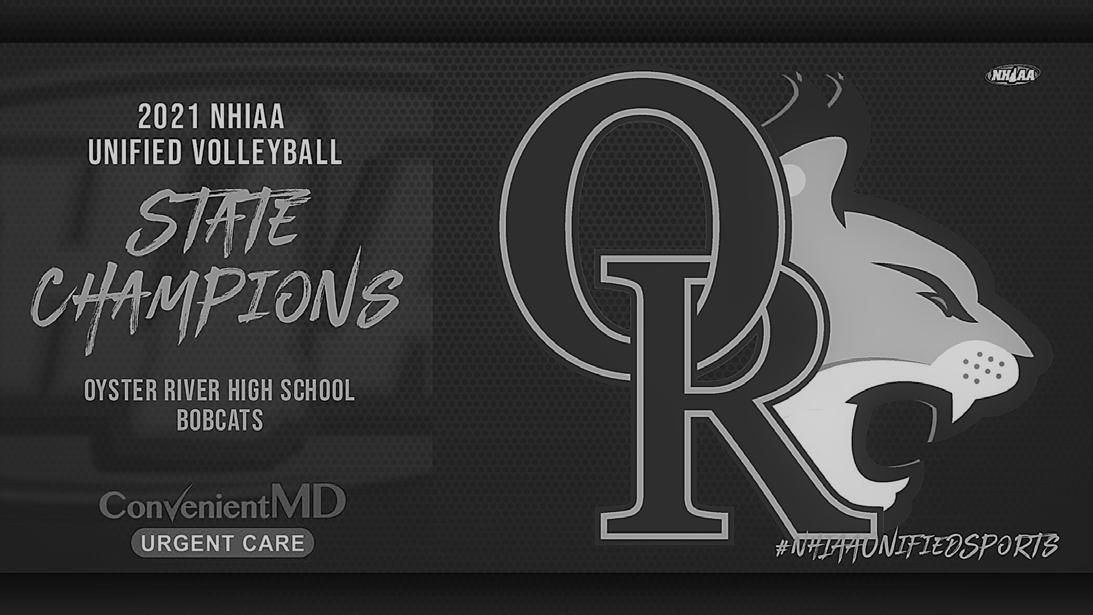
Satterfield is now starting the 2021-2022 Unified Basketball season. As he starts the season with two new championships un der his belt, it’s no surprise that the students of Oyster River can expect their school to have three Unified teams that all come out champions, and it couldn’t be done without Satterfield.





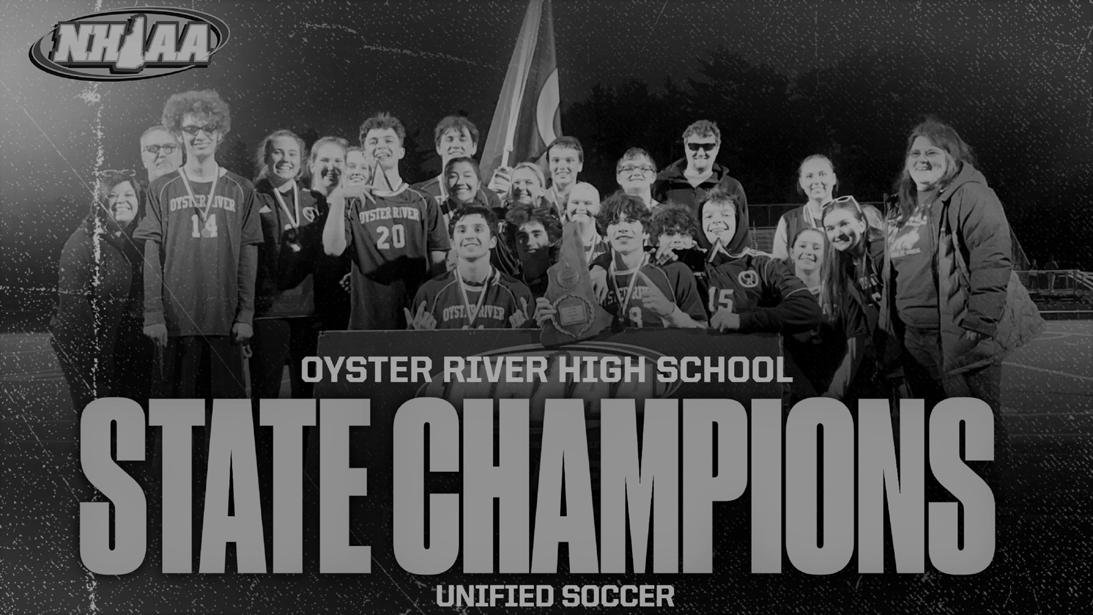
- Tess Brown
(Photos taken from NHIAA Twitter)
“The players love playing for him. I think he just has a great temper ament, he takes it seriously but also knows when to have fun. I think the players enjoy coming everyday and enjoy being around him.”
To Tip or Not to Tip
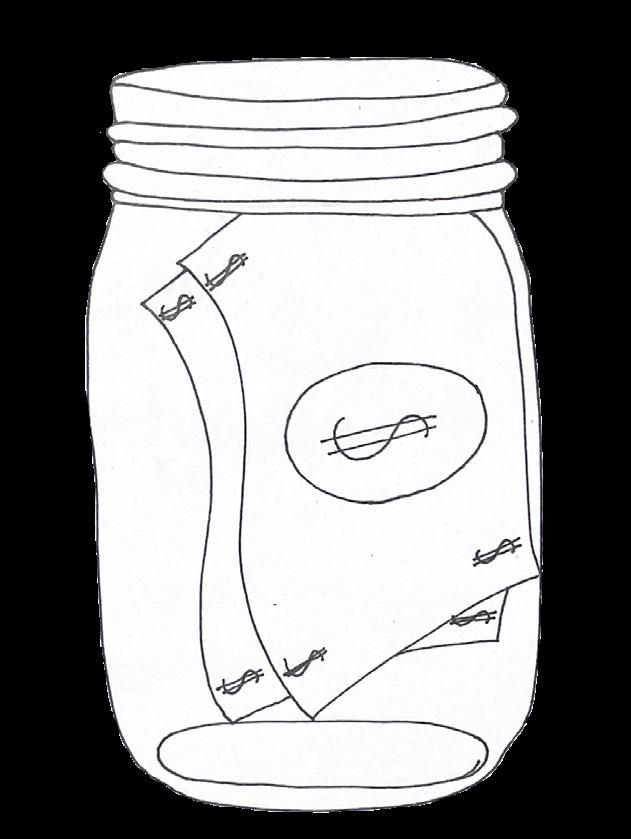
After a busy Sunday night at Dover Delite, I pick up the last or der ticket as it slides from the printer. Exhaustion floods through me as I scan the small label that reads, “Ginger: 1 Quart, x3.” My eyes flick to the clock: one and half minutes until we close. Reluc tantly, I lift the 3-gallon tub resting on top of the ginger ice cream and reach way down to the bottom of the cooler to scrape at the brick-like dessert. Our staff waited the twenty minutes past clos ing time that it took to hand-pack the three quarts of our hardest ice cream to scoop. Expecting to see any sign of green as I glance over at our tip jar, I roll my eyes as I realize that the customer decided to order so close to our closing time and still didn’t tip.
As someone who works for exactly minimum wage in New Hampshire, $7.25 per hour, I find myself questioning if it’s really worth it to work somewhere where I rely on tips for most of my income. Income from tips is built into the food service industry with the idea that if you provide great service, then customers will


that if it’s in your capability, then yes, you should tip because, even though it’s a dumb system and we shouldn’t have to rely on tips for our wage, it’s the reality for a lot of people in the service indus try,” she said. Especially for waiters and waitresses, the tip that you give can make all the difference.



Pay for waiters and waitresses in New Hampshire varies by restaurant, but according to GlassDoor, the average hourly wage is $4.00. While, in theory, this means that better servers will receive higher pay from tips, it also means that we, as consumers, have to do our part in the food service industry by tipping the right amount for the service we receive. For waitstaff, I tend to tip be tween 15% and 20%, but never below 10%.
reward you with tips. However, no matter how good the service is, people often don’t tip as much as they should if at all. This may be because people are unaware of the amount they should tip or simply because they don’t feel like dropping an extra few dollars. So, how much should we really be tipping for services and why is it even important?
For me, tipping is something that I always think about regard less of whether I’m dining in, ordering take-out, getting delivery, or being served by a behind-the-counter worker. It’s a courtesy rather than something that I consider to be a burden on my wallet, and the amount I tip relies on the quality of service and the amount of work that an employee is doing. Depending on the type of service, I generally tip between 10% and 20% of the cost of my food.
To really understand how much we should be tipping, we should answer the question of why it’s important to tip in the first place. For one, employees often see tipping as a sign of appre ciation for the hard work that they do. Natalie Lessard (‘22), a hostess and server at Street in Portsmouth, said that tipping “almost feels like [the customer is] appreciating me. It’s probably, for them, just another transaction. But for me, I’m like, ‘thank you
Another important thing to remember is that workers in the food service industry often rely on tips for much of their wage. Lessard said that most of her income comes from tips rather than the minimum wage that she is paid. “I think
Tipping workers in the service industry is particularly im portant now because of the current state of the economy. “Es pecially considering the increasing prices in stuff like gas, I’m having problems getting gas because it’s a far drive to where I work… without [the tips] it would be much harder for me to get to the places I need to be,” said Margeaux Burnham (‘22), a behind-the-counter ice cream scooper and server at Kilwins in Portsmouth. As someone who also has a twenty-minute commute to my job at Dover Delite, I understand the struggle of weighing whether the amount I’m paid is worth the gas money. The tips we receive help to account for the rising prices in our economy that aren’t followed by the same rise in minimum wage.
Given so many reasons to tip workers in the service industry, why do customers choose not to? Many people who are finan cially able to tip choose not to, not because they are malicious or they don’t appreciate the service, but because they don’t want to spend any more money than they are obligated to. I often go out to dinner with friends and hear the excuse that they can’t afford to tip, but then they go and buy an entirely new wardrobe the next day. Gracie Gallagher (‘22) put it as, “if you can afford to go out to dinner, then you can afford to tip. I feel like that’s kind of some thing to live by.”
Another common issue that customers face is knowing what an appropriate tip should look like for a specific service. While many agree with my philosophy that the amount that we should tip depends on the quality of service and the work that the employee is doing, I also agree with Lucy Picard’s (‘23) claim that we should always tip something for food service, even when the quality may be lacking. “I’ve had servers that are more rude, but I still tip them because everyone has a bad day and I understand if they’re not feeling it,” she said.
In contrast, Zach Serrano (‘22) said that he always tips “based
“if you can afford to go out to dinner, then you can afford to tip. I feel like that’s kind of something to live by.”
on how I felt the service was. I tip based on quality, not based on my obligation to tip.” While Serrano’s criteria align with how I generally tip, I still always give workers at least 10% for the same reason that Picard mentioned. I feel strongly that it’s important to be practical while tipping, but also empathetic. While using both of these standards, how much should we really be tipping?
Being served by someone behind the counter, such as an ice cream shop or a pizza-by-the-slice kind of store, is an instance where I will tip about 15%. “At [Durham House of Pizza] I’ll give a 10% tip, which is usually a dollar. I don’t feel obligated to tip 20% because oftentimes I’m just getting slices, and they’re literally moving a slice of pizza to a box… I’m not gonna tip 20% for doing 30 seconds worth of work,” said Serrano. Considering the amount of work that goes into relocating a slice of pizza, I understand where Serrano is coming from. At an ice cream shop, however, I generally tip more because of the work that goes into scooping the ice cream.
While working at Kilwins, Burnham expressed that she doesn’t usually expect tips, but she appreciates them. She said, “it’s less
bag items, seating and cashing customers out, cleaning tables, and making sure the take-out orders are correctly put together. “You’re doing so much work for every single order and so when you don’t make any tips it’s kind of disappointing,” she said.

Gallagher said that she is responsible for other duties in the restaurant, as well. “It’s so short staffed, so you’re also running food when you’re not supposed to be running food,” she said. Now that I know the amount of work that take-out staff is respon sible for, I try to tip about 15% of the cost of my food.
of a ‘you have to tip’ and more of a ‘we’ve done all this for you, please don’t just leave us hanging.’” Many times, stores with behind-the-counter service share the tips they receive with all of the employees working there, so by under-tipping your server, it’s actually a disservice to the whole staff.

Tipping for takeout is something that is often overlooked, including by me. I have never been one to tip for takeout because I picture an employee seeing my online order and simply placing my items in a to-go bag, but after speaking with Gallagher, I re alized how difficult it can be. As a hostess and expeditor for Lilac City Grill, Gallagher explained that she is responsible for taking orders over the phone, plugging them into a complicated com puter system, sending it to the kitchen, helping other expeditors
Delivery is a service that I always tip highly for since it requires the delivery person to drive my order to my house. It’s convenient for me, but, since I live pretty far from the nearest pizza place, I know that it’s especially inconvenient for them. “[Delivery] is where I’ll tip 25%. That’s the only scenario in which I consider [tipping high] at all because you’re actually driving out to me and you’re driving to my house,” said Serrano. A 25% tip seems high initially, but if you’re ordering a $9.99 large cheese pizza from Domino’s for delivery, that’s only a $2.50 tip. That’s a small price to pay for someone to deliver a hot dinner to your doorstep while you binge-watch your favorite Netflix show.

Tipping doesn’t just benefit the employee, it can also leave you feeling satisfied that you made someone’s day. Working at an ice cream shop, many times people would throw whatever coins or dollar bills they had into our tip jar after ordering. Occasionally, a customer would tip way over 15%, sometimes even twice their original order. I remember how excited our staff was after getting a $50 tip from a woman who wanted to support our college edu cation and had been going to our store for years.
Lessard shared a similar experience at her previous job at Pizza Spinners. “There was this woman who would order deliv ery and no matter how much the order was, she would tip 50%. The delivery drivers loved her and she would always get special treatment at Pizza Spinners. It’s the best feeling ever,” she said. At the end of the day, how you decide to spend your money is up to you, but your tip might make all the difference to that ice cream scooper.
- Laura Slama“I don’t feel obligated to tip 20% because oftentimes I’m just getting slices, and they’re literally moving a slice of pizza to a box… I’m not gonna tip 20% for doing 30 seconds worth of work.”
Tiptoeing the Line of Toxic
Hi, my name is Evy Ashburner and I am not that girl.
I used to spend a lot of time watching ‘morning routine’ you tube videos of these teenage girls cleaning their rooms, making aesthetically pleasing coffees, and working out to try and get myself motivated and productive. Over the years, I turned from Youtube to Instagram, Instagram to Tiktok, and Tiktok to Pinter est. I was searching for motivation to be like these influencer-girls I was seeing on social media, but nothing seemed to really work.
Most of the people I followed were creators like Lexi Hadigo, Olivia Ponton, Alexis Ren, Kate Bartlett and the list goes on. These girls post pictures of their bodies, their symmetrical faces and never ending wardrobes or videos of their ‘model body’ workouts and always healthy meals. New lifestyle trends, like the ‘that girl’ trend, have been a recent phenomenon that have emerged on platforms like Tiktok, Instagram and Youtube. The 60 second videos show clips of young adults’ routines in their day to day lives, things like morning routines, workout routines, “what I eat in a day” or “my skin care routine.”



I’ve made goals and lists of things I can do to be like the ‘that girls’ that I follow, and I sit in my room and I wonder “why isn’t this working? Why can’t I be like them?” The truth is, these life styles are only realistic if you’re getting paid to do it. Monetized influencers on Tiktok and Instagram who started the morning

routines and lifestyle trends make money from creating videos of their day to day lives. A lot of them have sponsorships so they can show expensive skincare and makeup products, clothing from PR boxes that they receive frequently enough to have a new outfit everyday, and many even have personal trainers and dietitians to help them stay healthy. Normal teenagers have hundreds of things to balance between extracurriculars, piles of homework, sports, and social lives. So for many of us, there is no time to stop and photograph the aesthetically pleasing moments of our lives. What I’ve found is the more time I spend taking pictures of ‘aes thetically pleasing’ moments, the more I want to try and curate these moments just so I can post them on my story.
I hate to admit it, but I love social media. As a teenger there is nothing more grat ifying than looking at my Instagram account and seeing 68 comments and 600+ likes on a post. I hate that I run to my phone when I think I hear it buzzing, hoping that someone slid up on my story saying “wow, you’re so pretty” or “you’re that girl.” I hate that I’m so consumed in it, but I don’t stop. Because the truth is, it is gratifying when I’m pretending to be like the influencers I follow, I believe that I am. I think it’s great that social media influencers are trying to promote health and wellness. In fact a lot of viewers find lifestyle content inspiring or motivating. I know I’ve found it inspiring at times. Having strong, independent, and
“These lifestyle trends allow peo ple to hide behind screens and outfits and have a sort of “fake it ‘till you make it” attitude.”
healthy females in the public eye is fantastic progress for us as a society. And why wouldn’t you want to be like these girls we’re following?
So why is this influencer lifestyle so appealing to so many teenage girls? It’s because we all just want to be healthy, stable and on-top of things. But these lifestyle trends that glorify perfection, tip toe a fine line of motivation and toxicity. Like normal people, I go through waves of motivation. Sometimes even making my bed feels like the most impossible task. I would be lying if I said that watching videos of all these girls going about their day with energy is helpful and inspiring. It usually just makes me ask my self “Am I not even good enough to make an aesthetically pleasing breakfast?” It’s almost alienating in some ways, and makes you feel like being tired and unmo tivated is wrong or not-normal. From time to time I will watch a youtube video called “My That Girl Morning Routine” and have this surge of motivation to fold the laundry on my floor, make a pretty colored smoothie and do all my homework at one time. But it’s temporary. I have spent so much time trying to take videos and pictures of myself being fake productive, hoping that it would inspire me to actually do some thing, but it never works. The motivation doesn’t last and the next day I’m back, laying in bed scrolling through social media and focusing on unproductive thoughts. I start to think about stupid things like “does she miss eating junk food?” and sad things like “ I wish I was as skinny as her.”

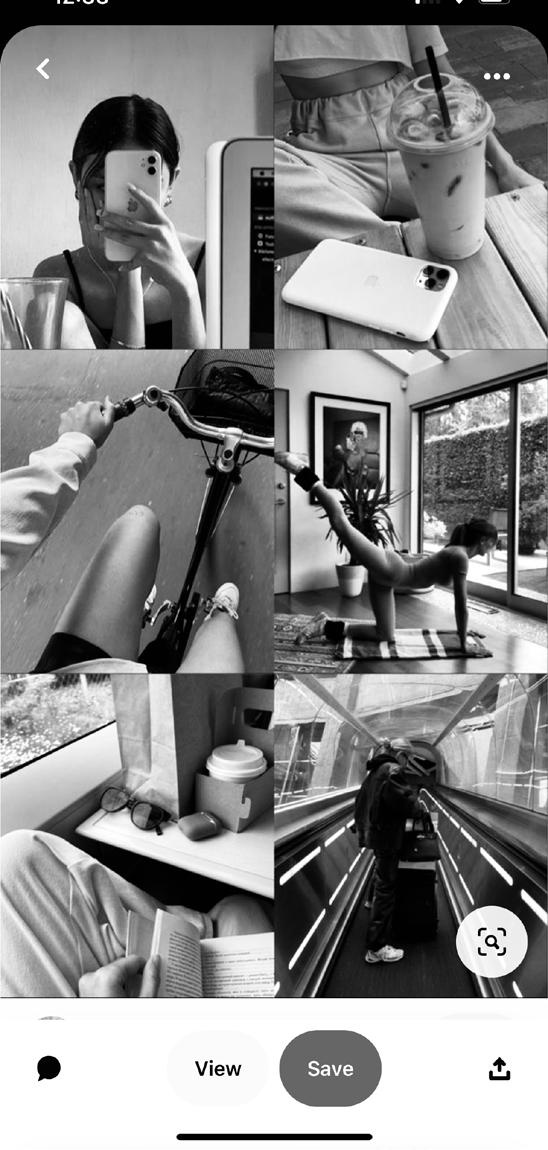



When we are bombarded with all these videos and images of girls our age flawlessly checking off their to-do lists, these posts only lead to comparison between our lives, and curated clips of this “perfect lifestyle.” I know that these creators and influencers are real people who have lives and emotions and struggles, but the vacation photos, mirror selfies and shopping sprees are so ap
pealing, I choose to forget they are real people. As a teenage girl, when I see these influencers somehow handling everything so well, there’s this surge of jealousy. This want to be like them. Even though the goals of these lifestyle trends are to inspire people to take care of themselves, it’s become a sort of ‘aesthetic’ that people want their lives to look like. The trends allow people to hide behind screens and outfits and have a sort of “fake it ‘till you make it” attitude. If everyone assumes that I’m not struggling and that I’m put together, maybe I will be?
The truth is you can’t dictate someone’s struggle through 60 second videos, or outfits and accessories. We neglect to remember that the content these creators choose to put out on the internet is just selected moments. That’s what makes their 24 hour days seem flawless. Who you choose to follow or watch on social me dia is up to you, but I’ve found that unfollowing the creators that posted unrealistic content has made me so much more secure in who I am. Trying to be like the girls I was following on social media is simply a waste of time because I’m not them.
Everyone (whether they admit it or not) procrastinates and goes through ups and downs of productivity and emotional stabil ity. So who are we to assume a person’s entire life looks as it does on social media? Lifestyle trends will never go away, and there will always be a new version of “that girl” on whatever platforms we will use in the future, we need to make sure that whatever defines the next trend is based on accepting people for their good and bad, their lazy and productive, and normalizing perfectly human traits.
I’m not that girl. And that’s okay.
- Evy Ashburner
“I start to think about stupid things like ‘does she miss eating junk food?’ and sad things like ‘I wish I was as skinny as her.’”
Bring Back American Studies
ShawnKellytaughtAmericanStudiesandalso advisesMOR.ShawnKellyhasnovoice,opin ion,orswayinthisarticle.Iamwritingthis purelyforthereasonofwantingotherstudents tohavetheopportunitytoexperienceAmerican StudiesinfutureyearsthewayIbelieveitshould be.JenniferWeeks,anotherEnglishteacher, helpedwithadviceandgradingonthispiece.

Ria Varki (‘22) expected to be completing her American history credit in a “boring” class where she had to memorize the dates of historical events and the names of old white men who took part in the American Revolution and Civil War. Instead, after taking American Studies, Varki was shocked by how much information carried over with her, how interesting it was, and how many laughs she got out of it.
American Studies, a class that is a mixture of American history, literature, writing, and art, has been a team-taught class since the early 1970s at Oyster River High School. Shawn Kelly, an English teacher, and David Hawley, a social studies teacher, continued that tradition together over the last seven years. Due to COVID-19 last year, the class was cut this year for cohorting purposes. Next year, it will return to the pro gram of studies, but the course won’t be the same as it was. As of right now, the class is going to be held as a 40 student lecture. Making American Studies similar to a lecture hall in college would take away important class aspects, such as small group conversations, one-on-one help, and an engaging learn ing environment. I believe American Studies should continue as it was to maintain the quality of the educational experience.
American Studies was a fast-paced class that had high expectations for work and prepared students well for college. Although the work was challenging, the teachers taught me how to plan out my time, making it manageable by slowly building up a workload as the class went on. Through this, I learned how to make my own goals and schedules, and how to check in for feedback. I’ve also gained writing skills, retained knowledge, and made projects I fondly look back on. Any year in high school is a helpful time to take the class, but for me, taking the class sophomore year really helped me balance a busy schedule in my upperclassmen years. I’ve used the foun
dational skills from that class in almost all my other classes following that one.
According to “5 Benefits of a Smaller Class” from Fremont College, classes with 20 or less students have been linked to high grades, higher material retention, and faster learning. These benefits come with the opportunities to participate, get more feedback, and make classroom connections. For these reasons, big name, successful schools like Yale, Brown, Am herst, and Johns Hopkins, prioritize small class sizes, especial ly for the most crucial classes in preparing students’ for after highschool opportunities. These small classroom benefits are critical to the class American Studies, as student connection, feedback and participation are in the nature of the class sub ject. We should prioritize the small classroom environments like other well-respected institutions, if we consider writing, understanding American history and other skills, like manag ing a large workload, important developmentally for students.
The small classroom environment and foundational skills were appreciated by students other than myself. Hawley’s desk drawer is filled with thank-you notes from students who were appreciative of the skills they learned from American Studies as they continued their education in college. Hawley said, “we don’t get the thank-you note until the end of their freshman year in college when they have taken a humanities course and they’ve had an in-class essay. They are like, ‘man I’m so glad I got that [in American Studies] because I knew what I was doing [in college].’”
Sarah Lyon (‘22) is another former student who believes the class taught her many meaningful skills, aside from just inclass essay writing. She said, “I feel like it was one of the best prep classes I’ve taken in terms of college. It really gives you a chance to sit down and learn. There’s a big workload but they
teach you how to manage it, and work you up to doing nightly readings and responses, which is obviously pretty standard for college. Also, the work we did on The Crucible essay thesis, where we spent a week just learning how to craft a great thesis, was very helpful.”
The main way Hawley and Kelly helped students with these skills was through one-on-one conversations about goals students wish to reach in their writing, when doing homework, in-class participation, and more. Their help was especially evi dent throughout the many thesis papers on pieces of American literature in the class. Hawley or Kelly would meet with every student and help them come up with an original college-lev el thesis and give feedback on the way students evaluate it. Through the meetings and work, I really learned how to prove a point through writing and evaluating literature. Having some one really care about my writing and guiding me in class made me really care about my writing.
With that individualized format and aid, there was less motivation directly on grades and less competition in a rigorous classroom. Hawley said that most of the time he didn’t need to use grades as a motivator for students to want to improve their skill sets; the moti vator was growth. He explained, “more often than not, there will be a student who will be frustrated that they can’t figure out a thesis statement. Kelly and I will not provide it, but guide you through the process of doing it. It’s developmentally super hard, but then you get it.”
Ria Varki really enjoyed this approach, not only for motiva tion and acquiring skills, but also for how it supported her as a person. She felt there was a caring aspect of the class; it wasn’t all about being an ideal 4.0 student. She explained, “I really like how it wasn’t all about memorization and grading. It was always about projects that would use skills you need for the future, like graded discussions that would simulate meetings and in-class essays, essays, and creative projects where you would have to actually apply the material. As a result, I still know the mate rial now.” She continued, “the class puts value on you rather than just you as a student… I always felt valued as a person in that class, not just the work I put out. I learned a lot and it felt relevant.”
Despite American Studies’ ability to give students preparato ry skills, there are only two options that have been presented in continuing American Studies next year: splitting the class, and its teachers, into groups, or having a larger class. This is because the school needs to provide classes for a student body with a population 200 more than it was a couple years ago and teachers are required to teach a certain amount of classes. Noe explained, “if you have two teachers, all together if you count by semester not by year long class, they teach ten semesters a year. If you put two teachers in a room but it’s a 20 person class, you’re not running something that that teacher could be teaching. By
making it bigger, now you have more kids who can take classes they want to take.”
Although two classes could be taught during the time period of American Studies if the teachers individually taught class es or if the class had more students, I think having a small, two-teacher class is worth it for the skills and experience gained in American Studies. The teachers are not getting away with any less work. Rather, there are two teachers to account for the fastpaced learning environment and to give students the resources they need to succeed. Losing this small two-teacher classroom structure would make the class more challenging, less entertain ing, and just wouldn’t show the same amount of student growth.
The class American Studies is unique from other classes in that it’s not about just knowing the material and facts, but it’s about understanding it from the eyes of many diverse people. Everyone in the class picks up different concepts and concep tualizes them differently. The exchange of those unique per spectives and understanding is what made the class American Studies. Without discussion and collaboration, that’s harder to achieve in a large classroom and there would be a loss of that understanding. If we didn’t break down concept questions as a group, I feel that I would have gotten frustrat ed with workload, wouldn’t have a round ed view of history, and wouldn’t have been successful in assignments. Unlike other fast-paced classes, the answers were not in a textbook. They were in the minds of the class participants and all the people who lived in history.
Oftentimes we would display our understanding of historical events through projects and share them. Students did creative writing, paintings, and music. I personally used art to visualize and symbolize different issues, for example in slavery. To make the project, I had to understand the topic through reading com prehension and discussion. Looking at other people’s art gave further understanding of others’ perceptions. The class was a lot about working together but also had an emphasis on your own voice, opinions, and way of viewing things. Communicating those things was crucial to the class. Each individual under standing was important for the learning process.
Varki enjoyed conveying her interpretation and opinion because it made her feel important. Varki explained, “I was able to voice out my opinions more, and have it feel more like a con versation rather than a presentation with a bunch of students’ eyes. Varki continues, “we would have open discussions on the material and I thought that was a really nice piece, hearing other people’s opinions and what they thought. But, I also had a voice.”
The class discussions not only helped with learning per spectives but also created a fun and engaging class community. Hawley explained that his favorite part of the class was watching students break down the history together. He said, “I just love every day’s discussions and how kids respond to the reading and how to make that reading approachable, but also give the course
“I think just having a class that makes you excited about things that happened 200 years ago is really rare and just having good teachers and a good class environment is so important.”
- Sarah Lyon
Creative Response Projects From Past American Studies Students


a bit of levity because it could be pretty intense. The humor part of that is also fun making sure that there’s this balance of rigor, understanding complexity, and also the love of learn ing.”
The humor in the class really made all the hard work worth it by adding fun and keeping me focused. That was just one of the ways the class balanced work with fun. As concepts, readings, and projects piled up, students worked through that together with their teachers and got individualized help when necessary. While, like in any class, students did struggle with some aspects of the class, they ultimately gained the skills necessary not only for American Studies but also for future learning. As a result of hard work and individual attention, students improved immensely on skills, more than what could be expected in a 40-student lecture.
Varki explained how this format and feedback looked for her midterm and how it showed her growth. She explained, “when we started [the class], we came up with three things we wanted to work on for this year. In the interview [for the mid term exam] we talked about how we improved and I thought it was really cool [that] they actually came back to it.”
This was not the only way that American Studies brought attention to what students believed they needed to work on. American Studies yearly gets feedback from its students re garding what parts of class were most helpful, what additional support students need, and what can make the subject more engaging and comprehensive. Hawley explained that so much of what was done in class to learn material was student-based. He said, “the students drive a tremendous amount of that curriculum. So, whenever we did the course evaluation at the end of the class, Shawn and I would take that information and we’d process it. We usually would hang out and go on a backpacking trip in the summertime and we’d go through and try to figure out how to integrate the feedback and do our best to accommodate that. That would drive certain elements of content. We discovered that early on the theater work was a
really popular bit, so we integrated more little plays in the second semester.”
With a larger class, students would have less say what hap pens in the curriculum and wouldn’t get one-on-one feedback on skills they want to work on. That takes away from learning and interest. When students aren’t interested and they are thrown simply an agenda, learning becomes grade motivated. Lyon thought what made the class so great was the fact that material felt relevant. She said, “I think it’s really important they have that experience. Just having a class that makes you excited about things that happened 200 years ago is really rare and just having good teachers and a good class environment is so important.”
Because American Studies has offered students so much, it’s important to students and teachers to continue providing the level of educational quality for future students. Having this class is an important substitute for students who struggle to engage in a regular history class and who want the opportu nity to go the extra mile, gain many skills at one time, and at the same time get walked through it. Hawley explained that American Studies’ “intent is to give kids an alternative because it’s hard to find a good match. There’s a lot of folks who really enjoy that structure in U.S. [history], but there’s a fair amount who don’t. We’ve always been there for the fair amount who don’t.”
Hiring more teachers, to keep small class communities and amazing educational experiences, I believe is worth it. 70-75% of Oyster River students continue on to four year colleges, so investing in those students’ foundational skills would help their futures while making their present more enjoyable. The skills I obtained in American Studies were worth the extra time, teacher collaboration, and hard work. The most memo rable classes for students are in the ones where they feel a con nection with their peers and feel they’ve accomplished a lot. With that in mind, American Studies isn’t a wasted resource. Rather, it’s an example of what a class should be.
- Hannah MuessigThank you to all of our wonderful sponsors!




Thank you for reading our magazine!

Check out more articles on our website by scanning the QR codes below.







Changes in Student Behavior at ORHS Walking in a “Winter Wonders” Land
What are we Really Saying with our Wintertime Greetings?


